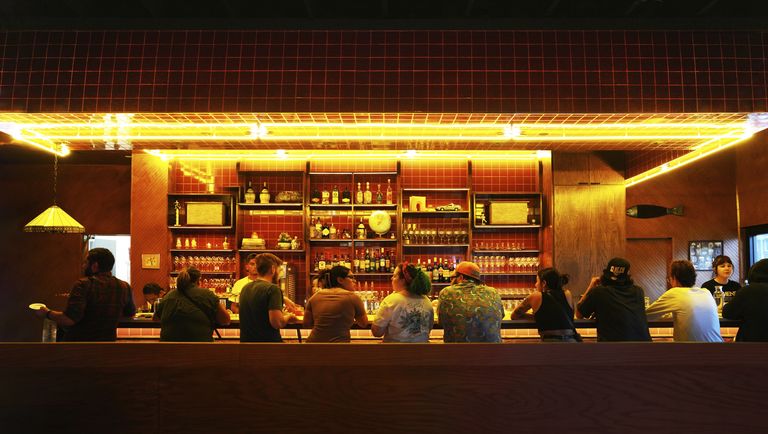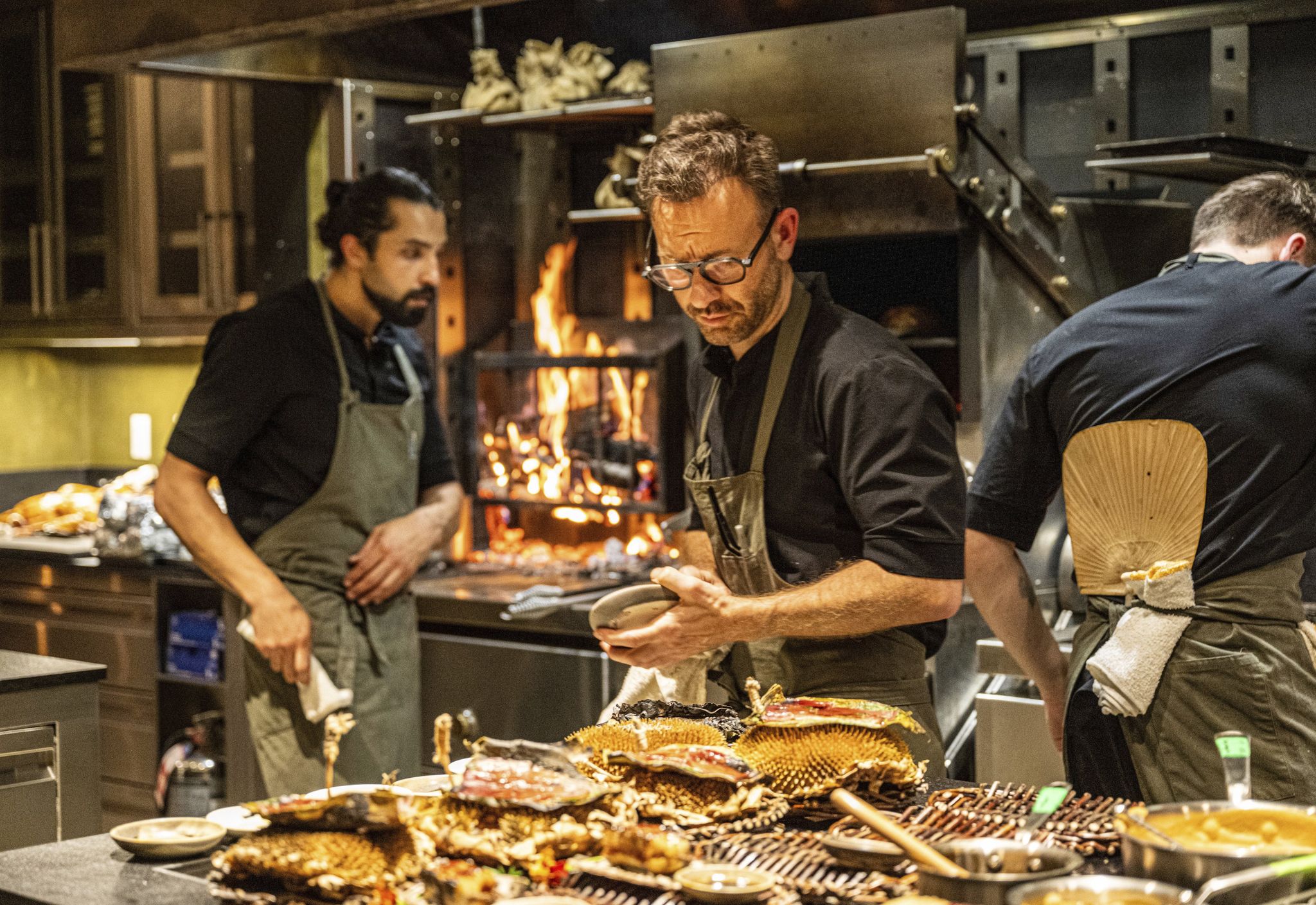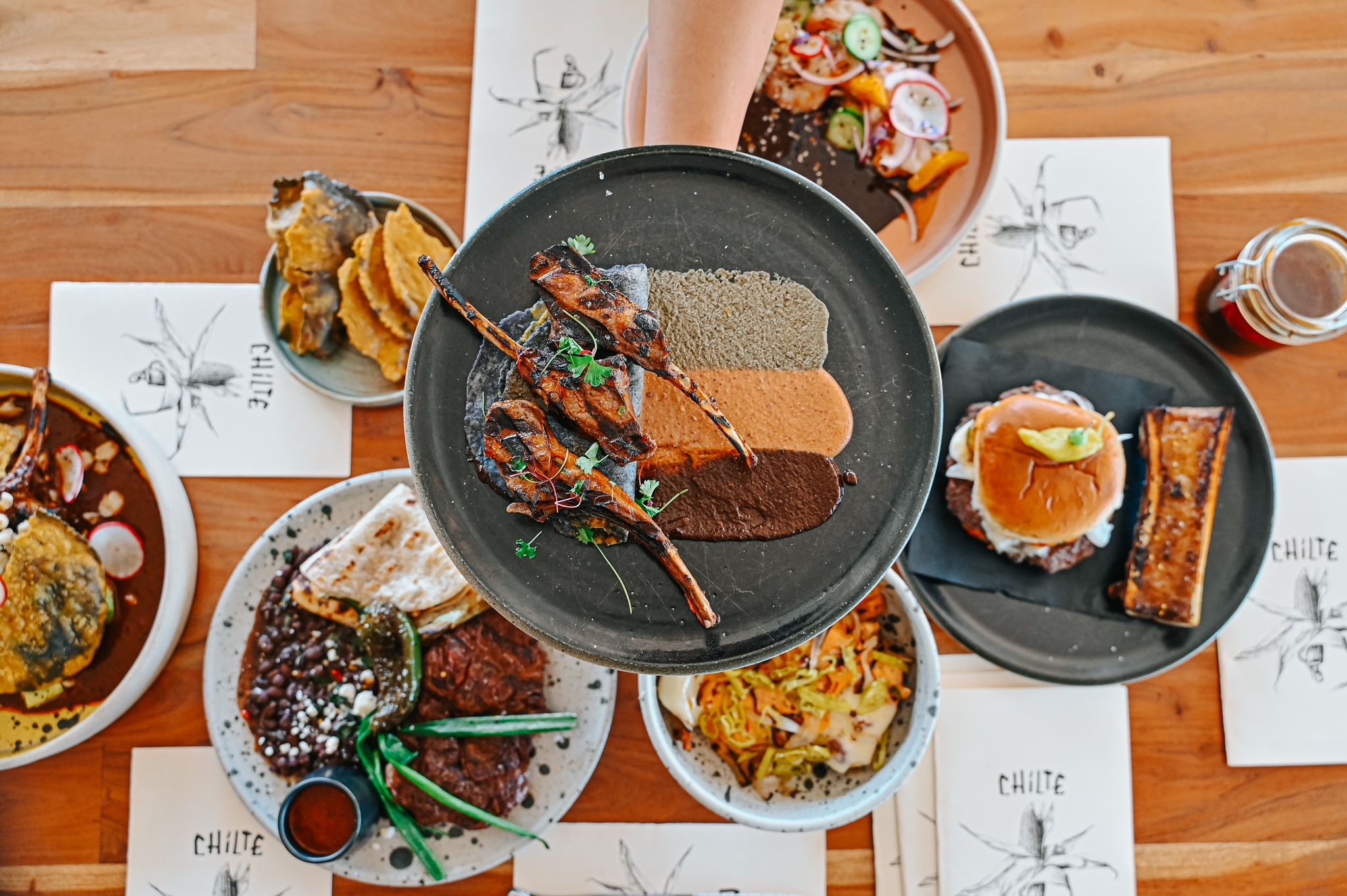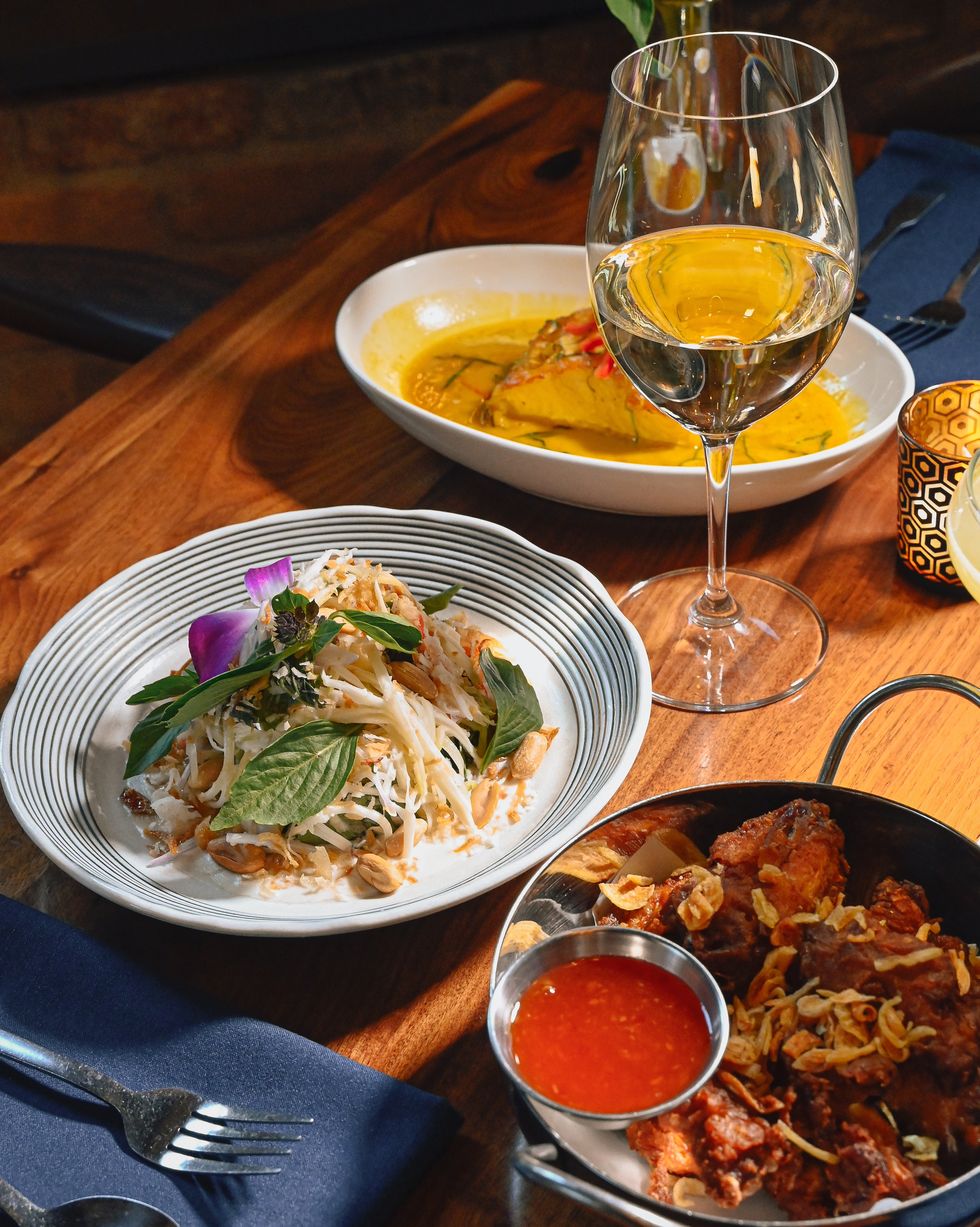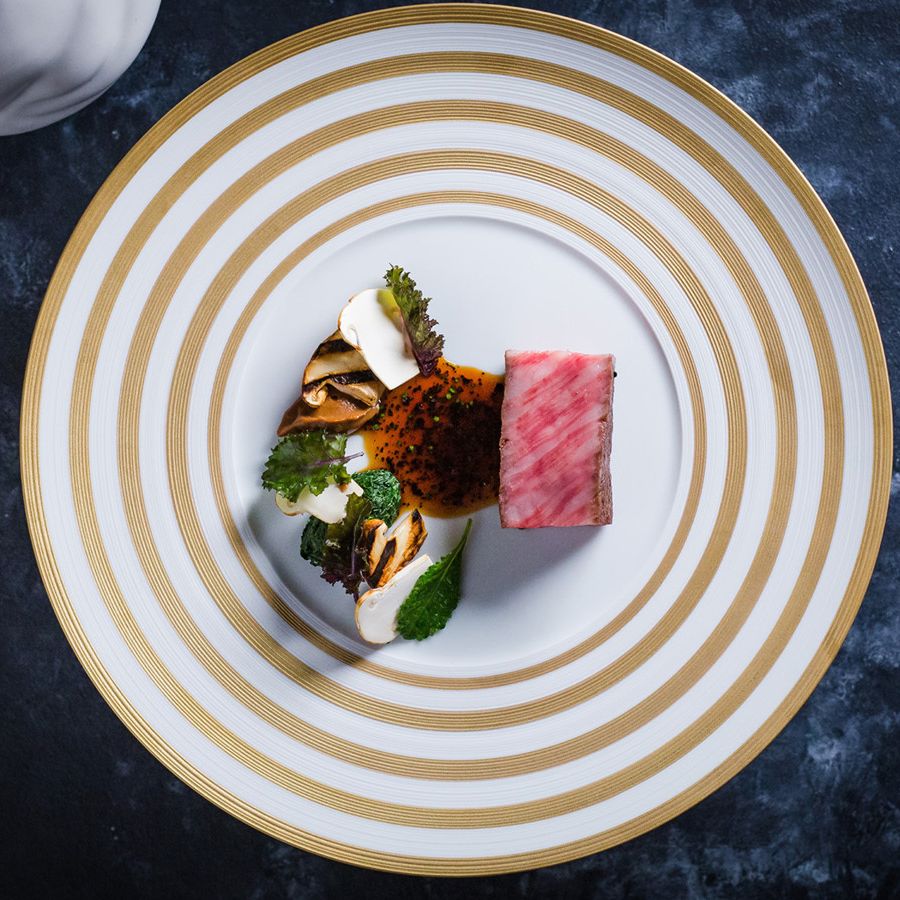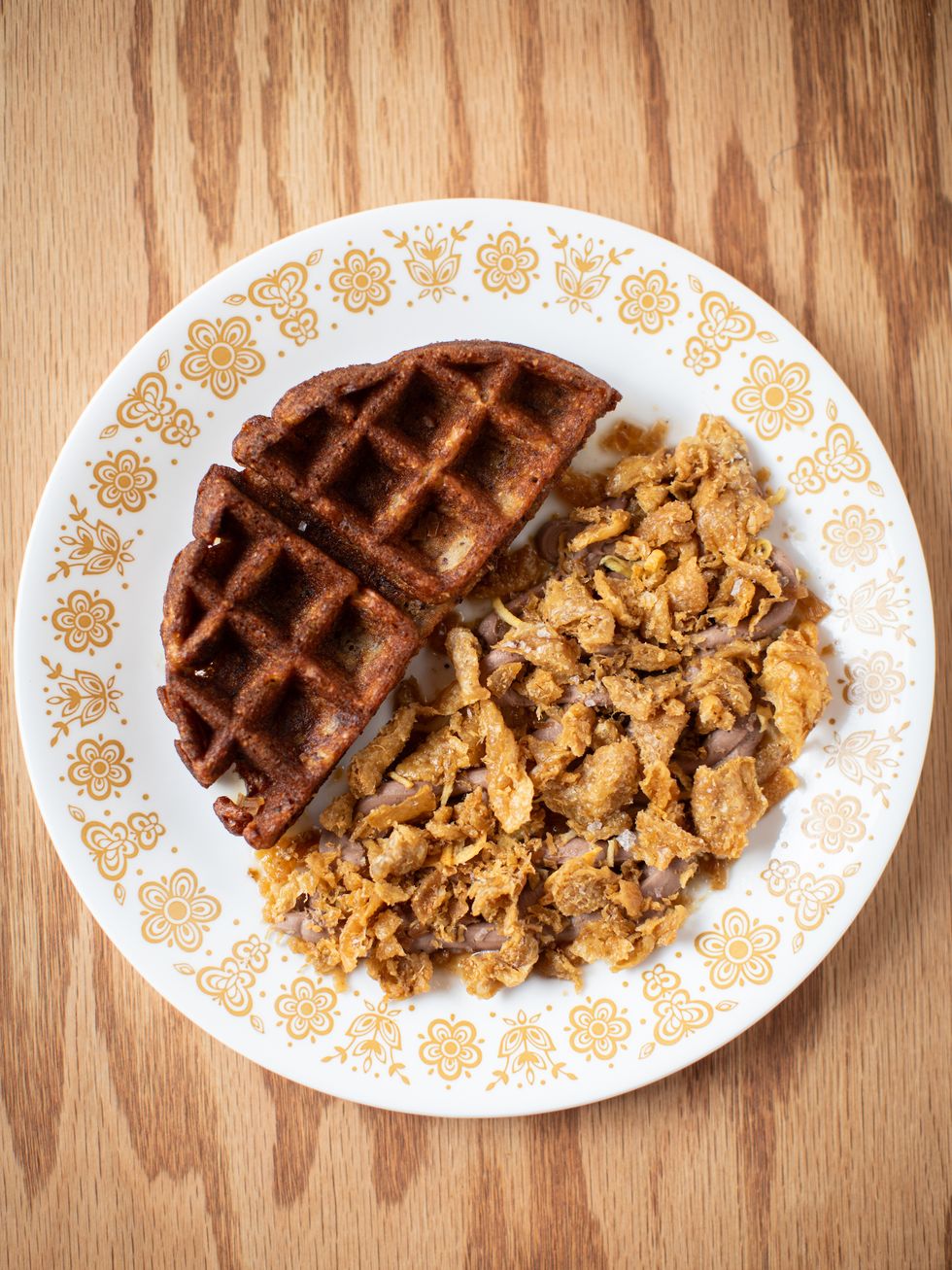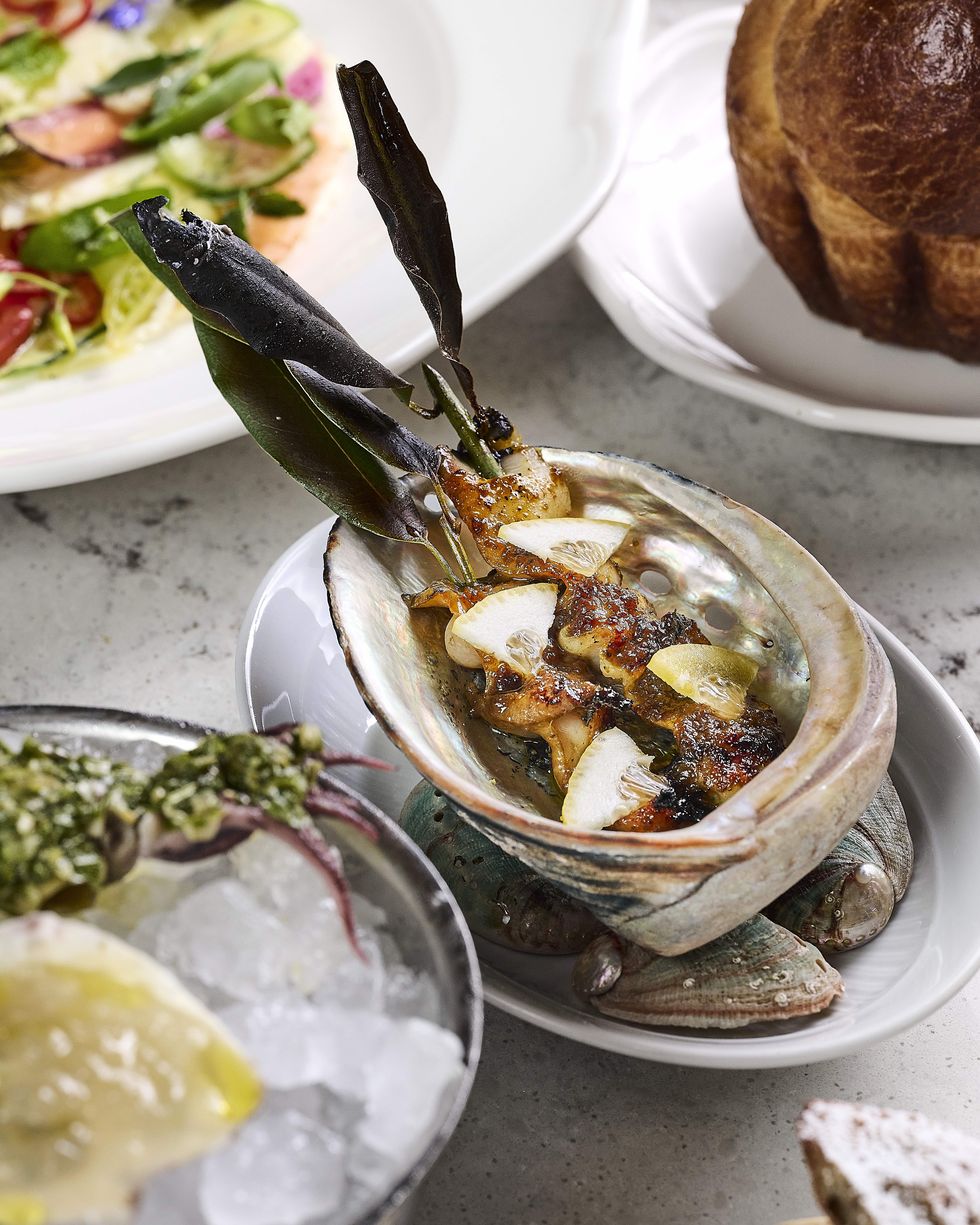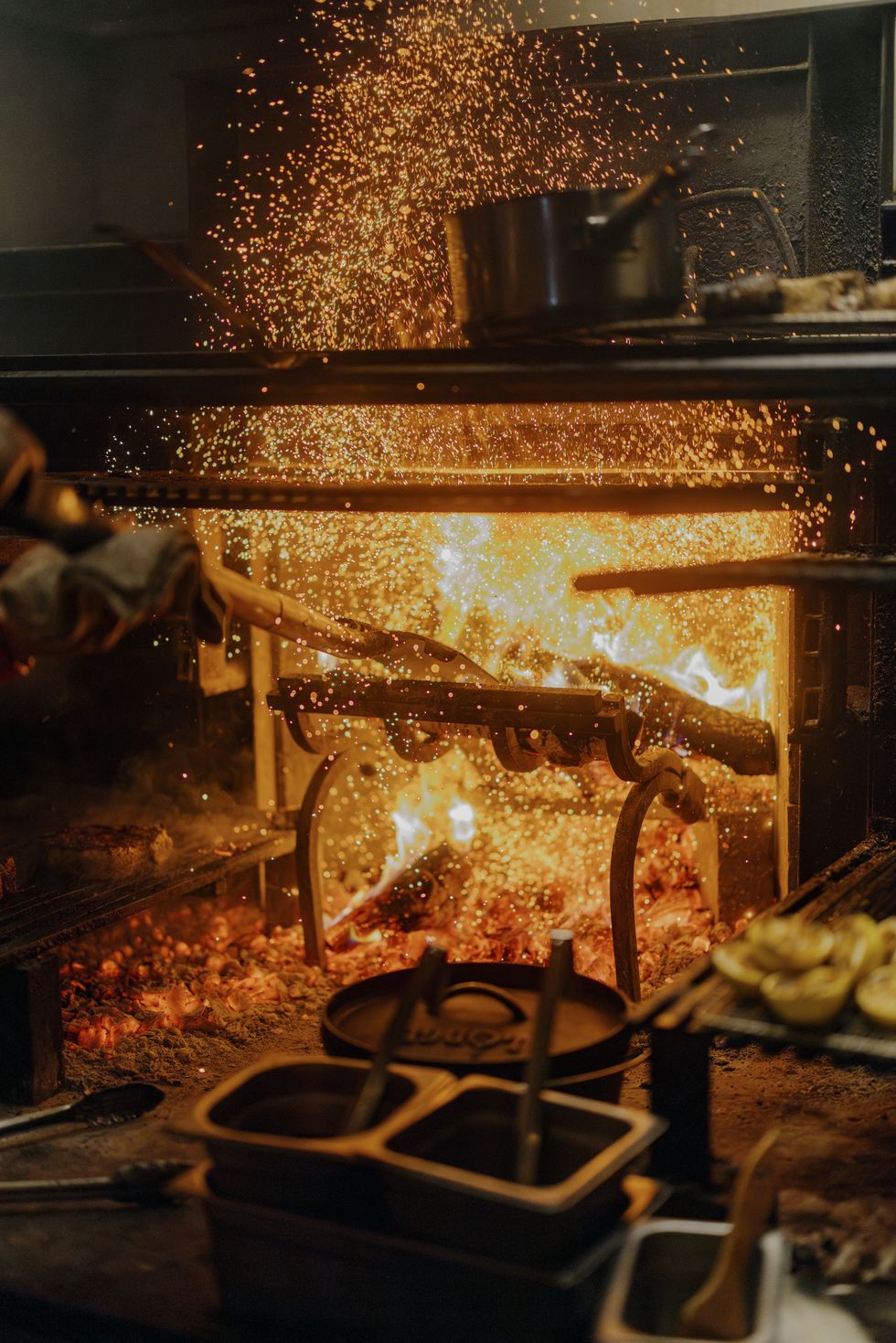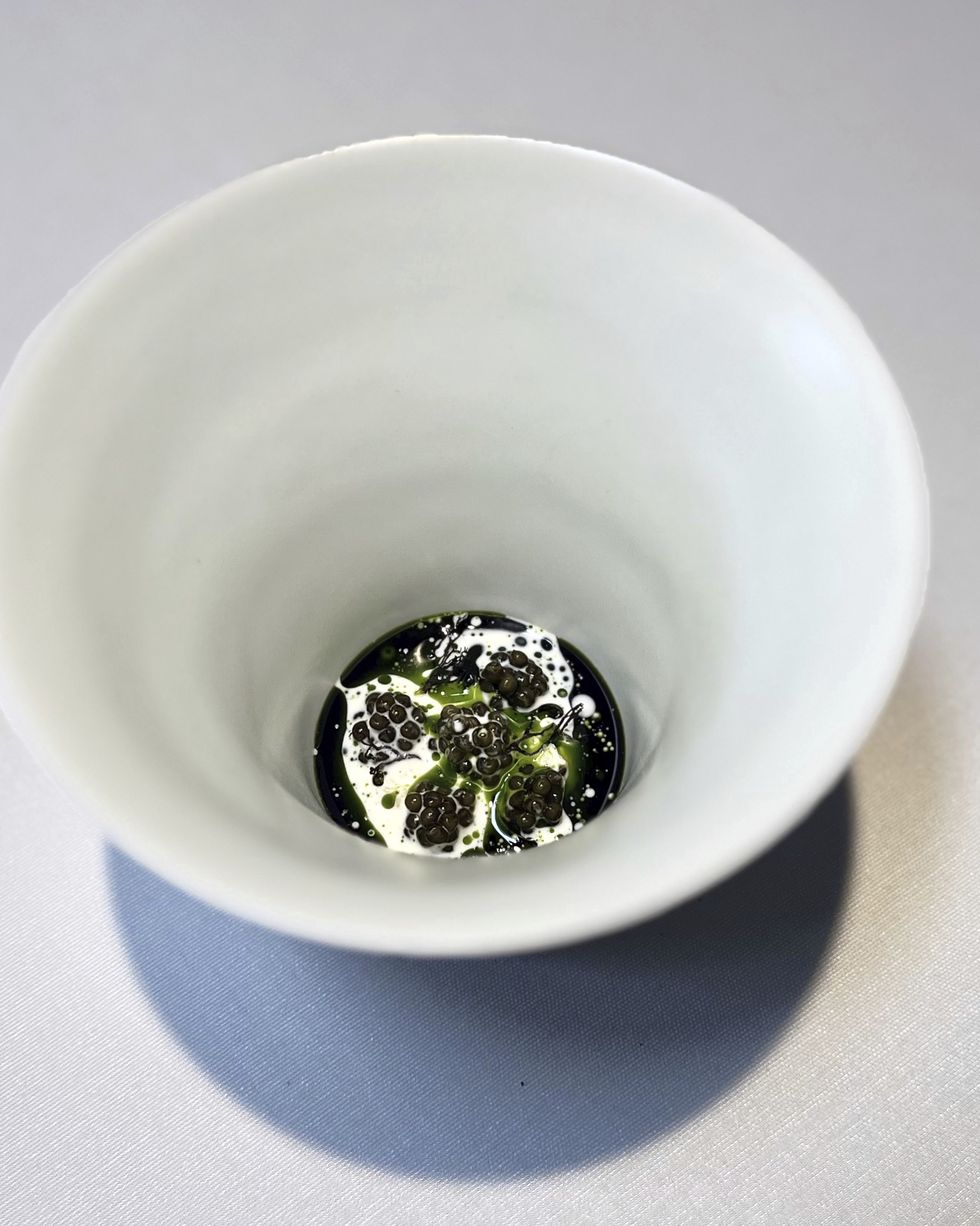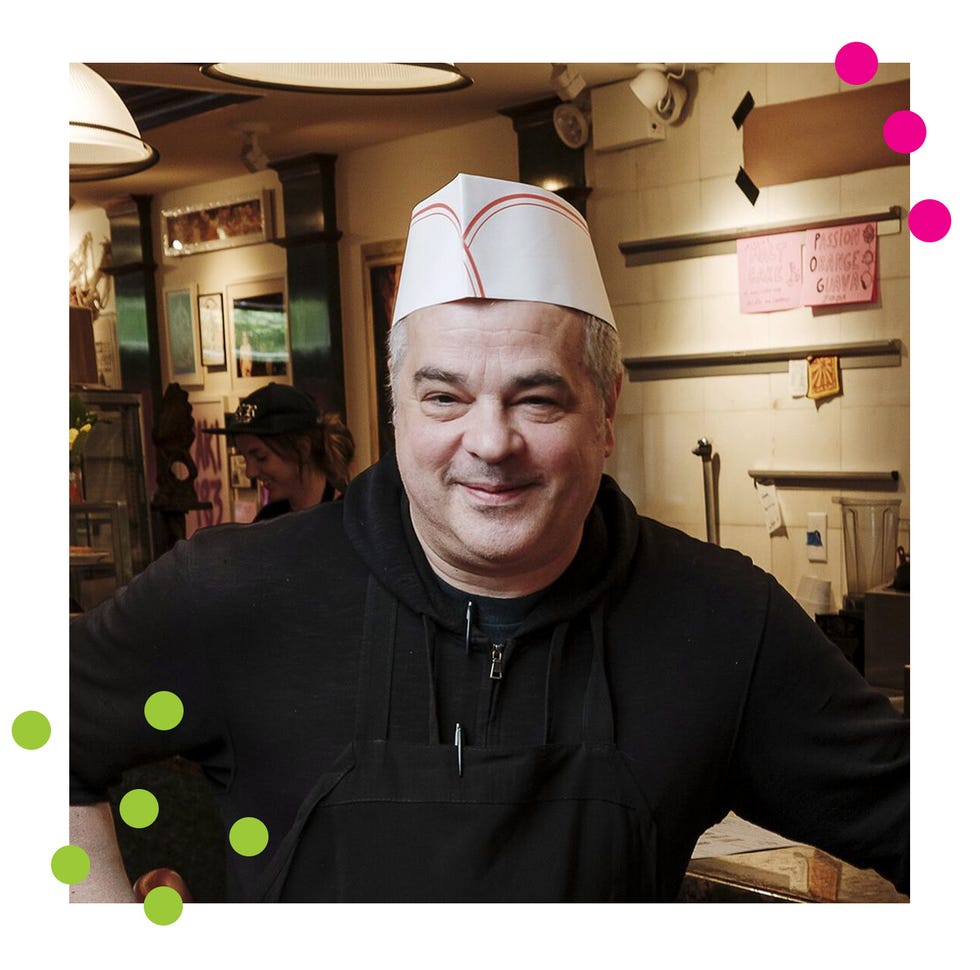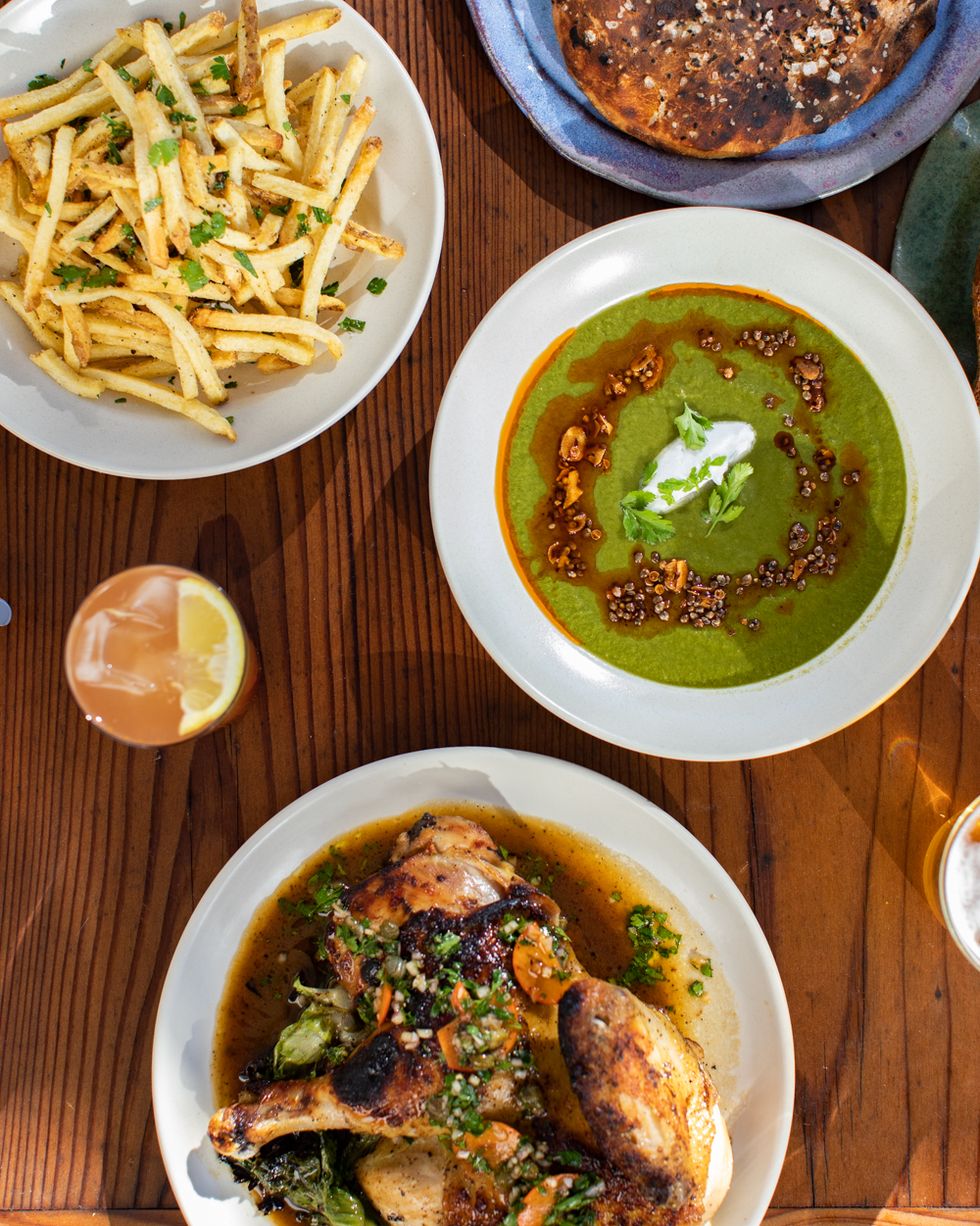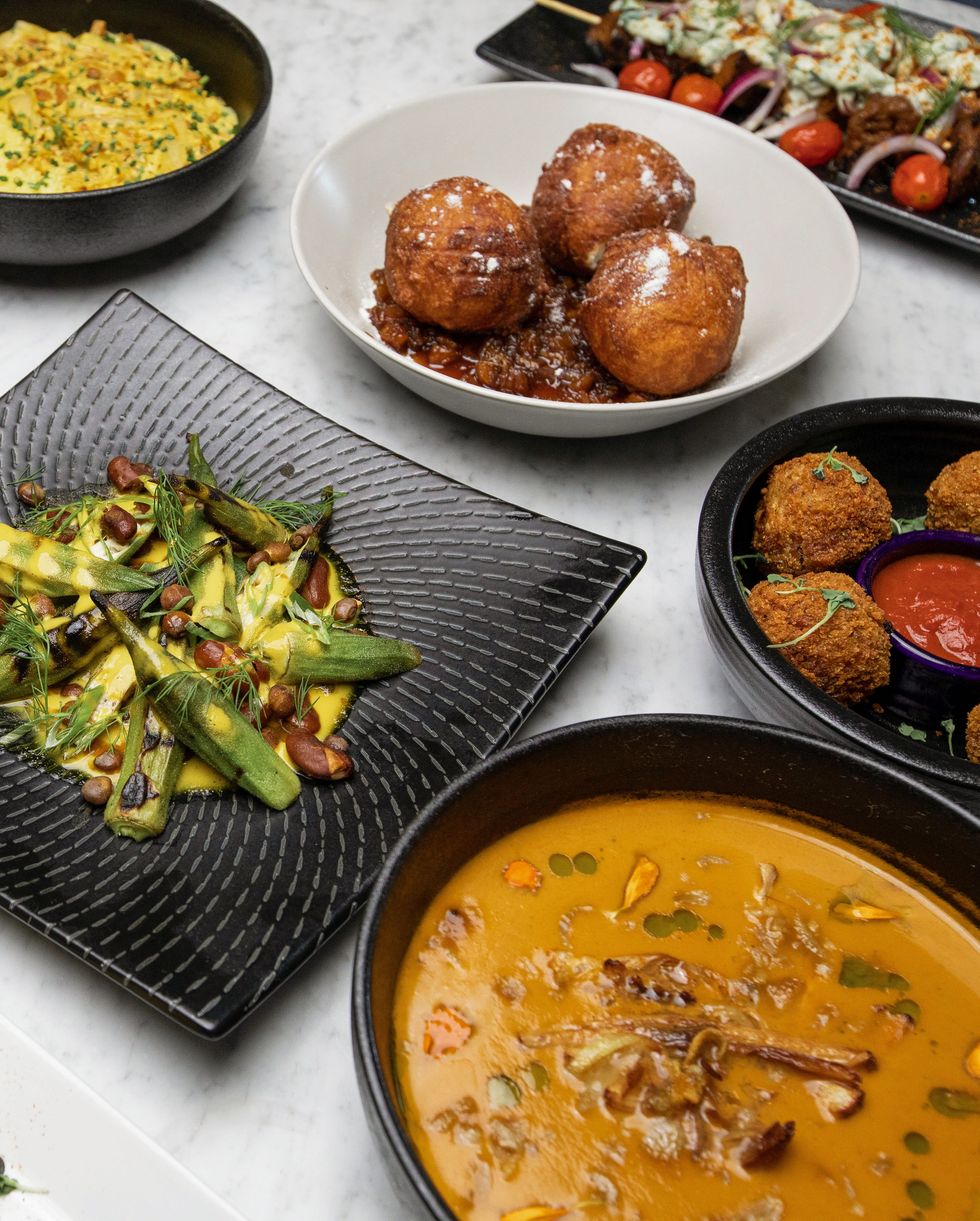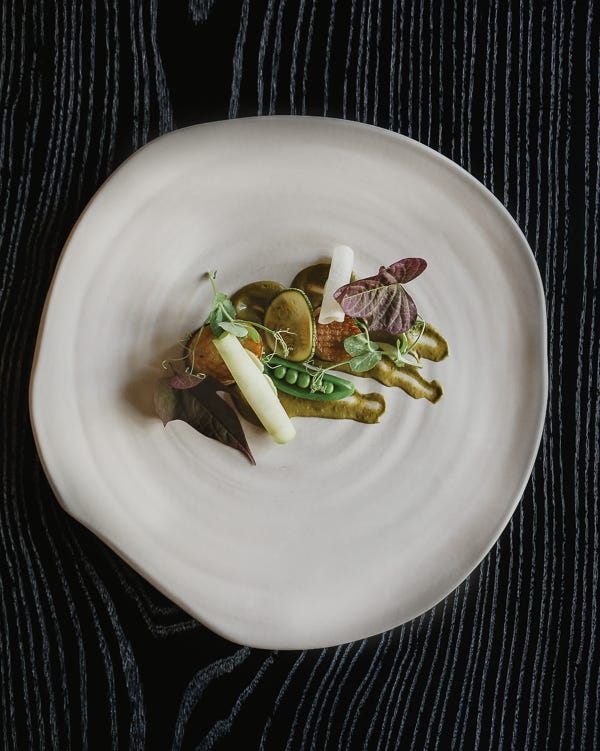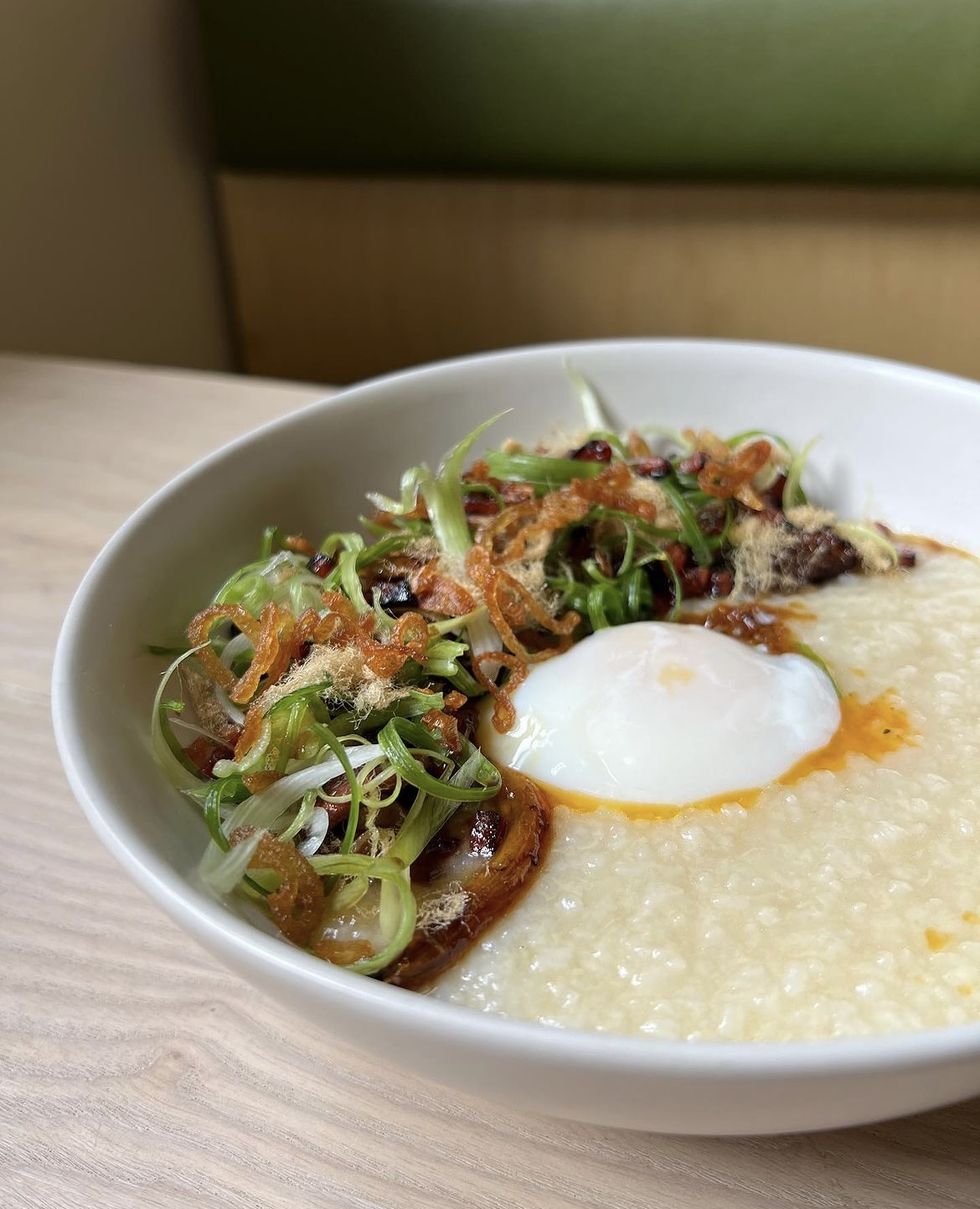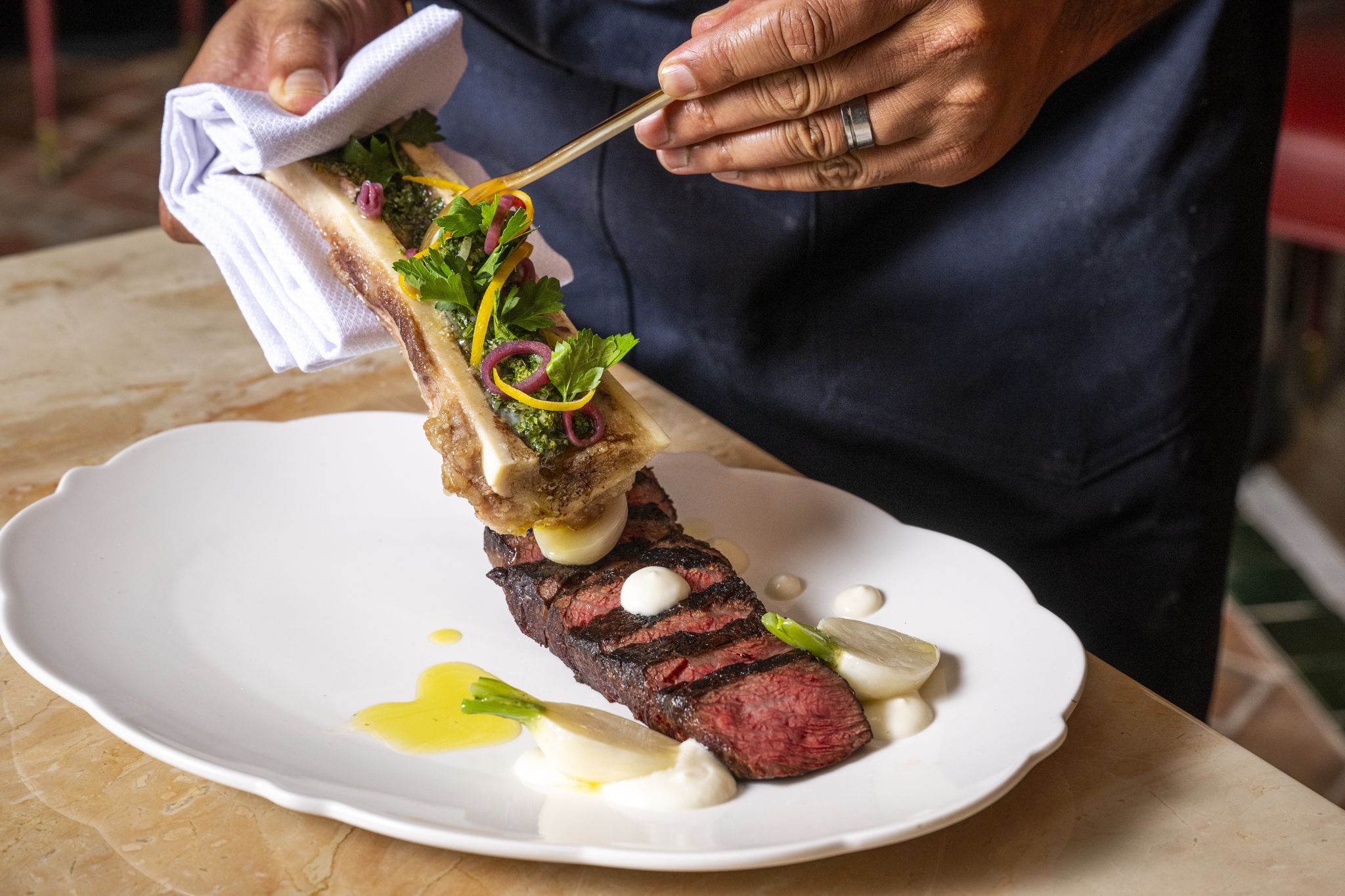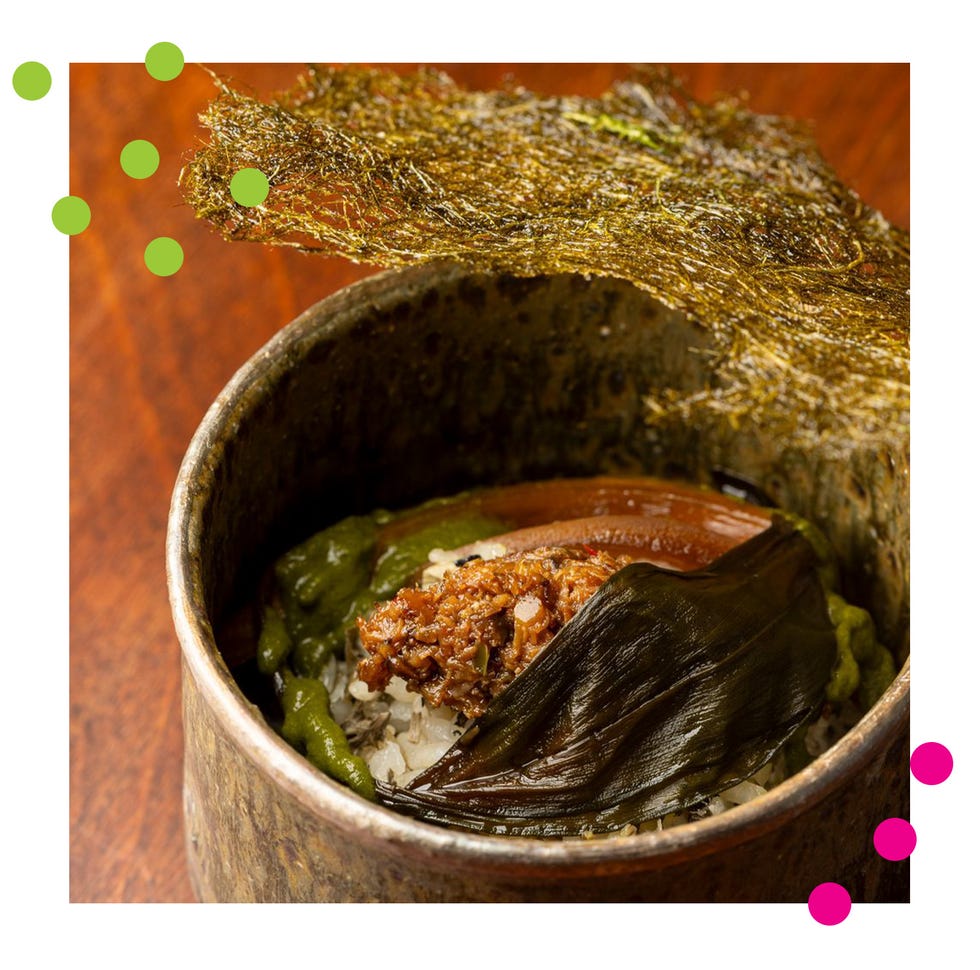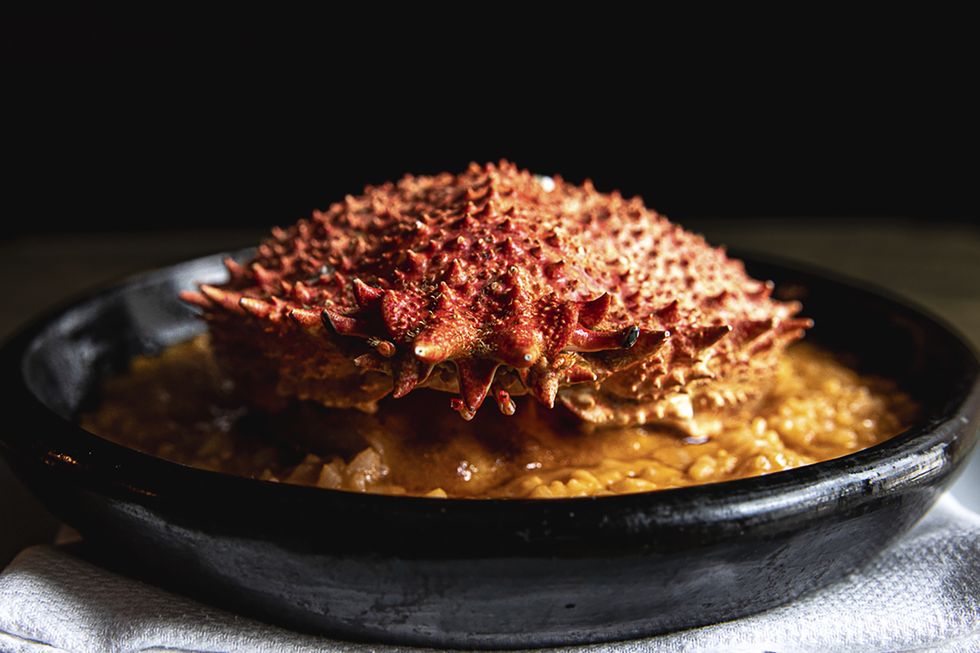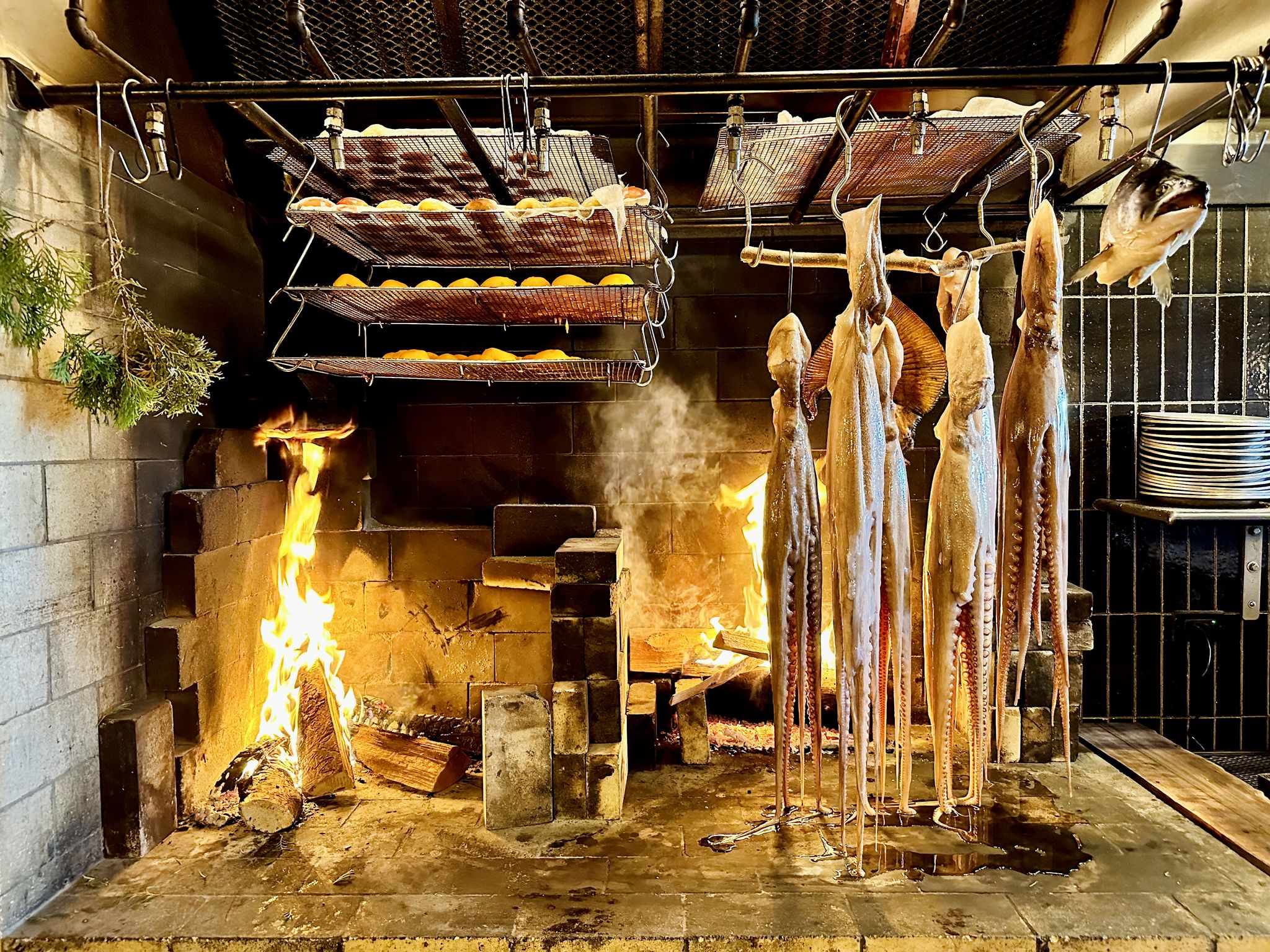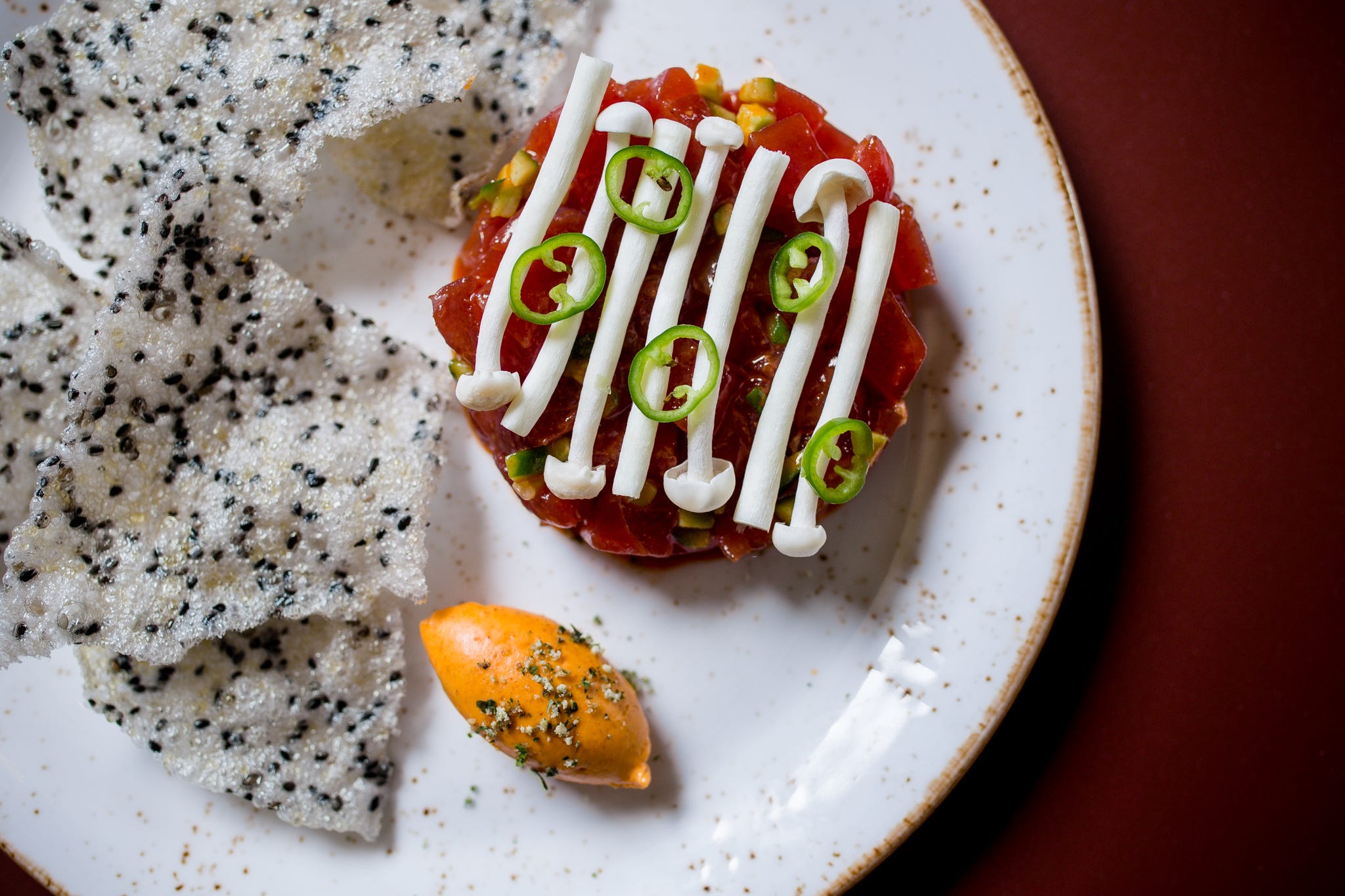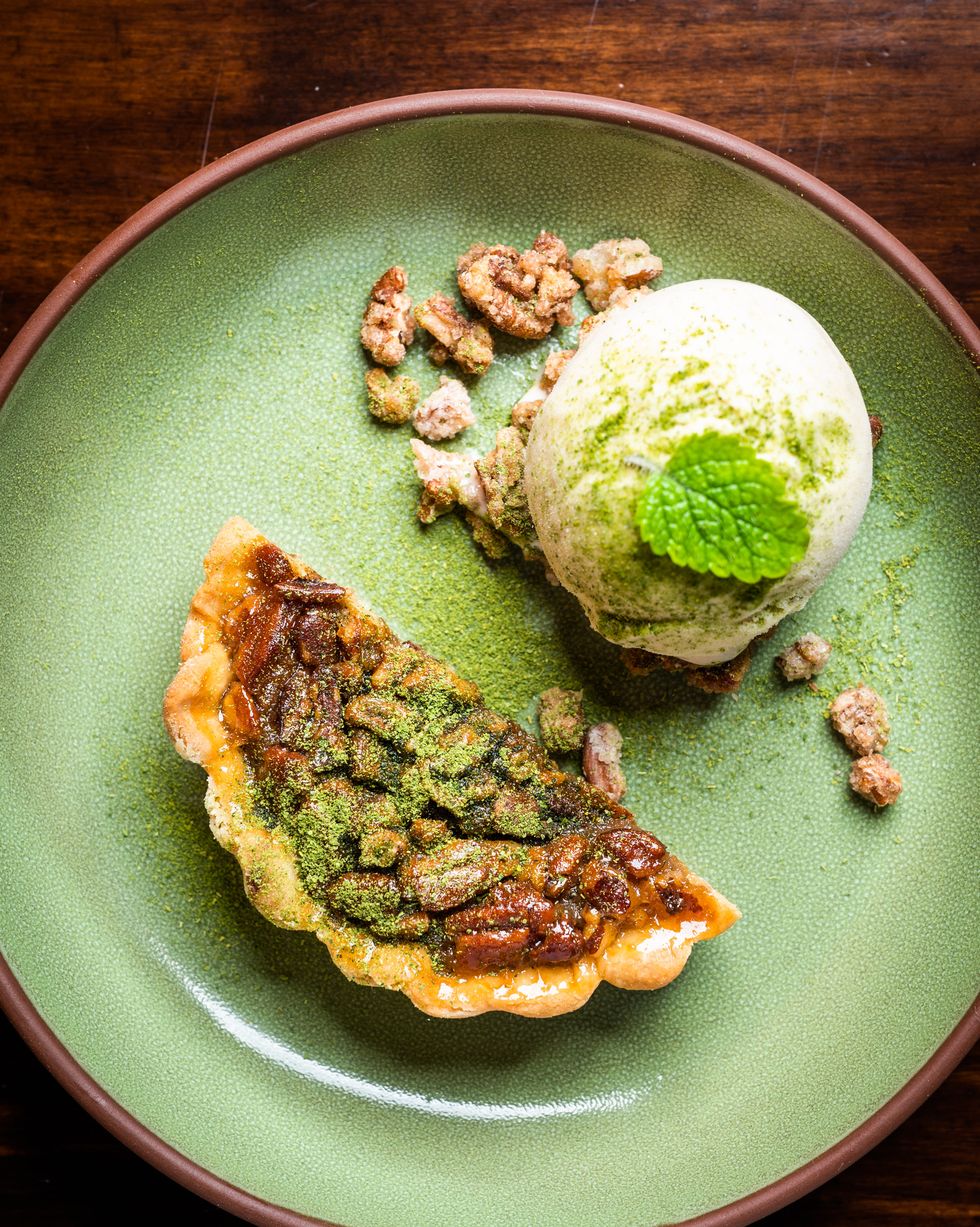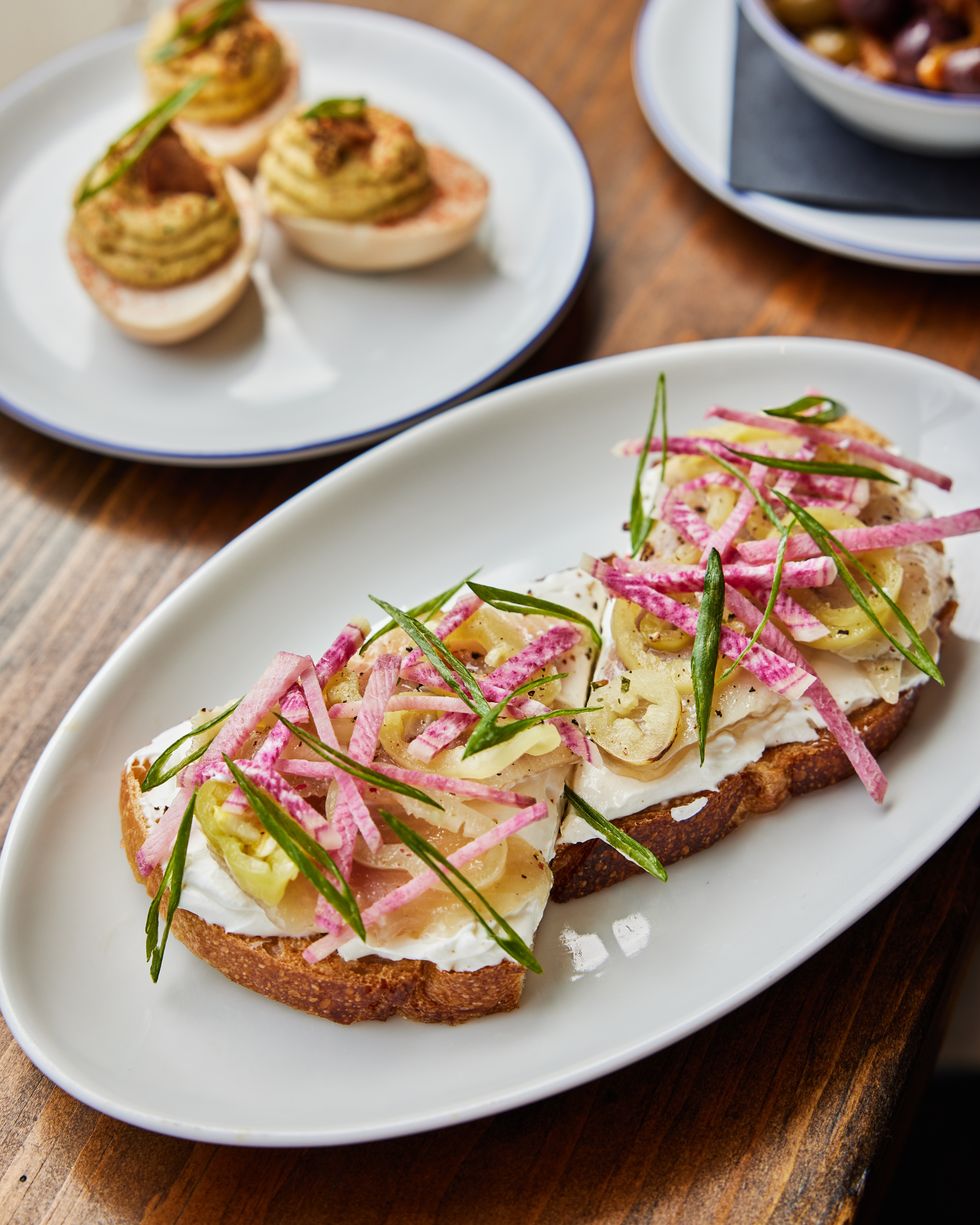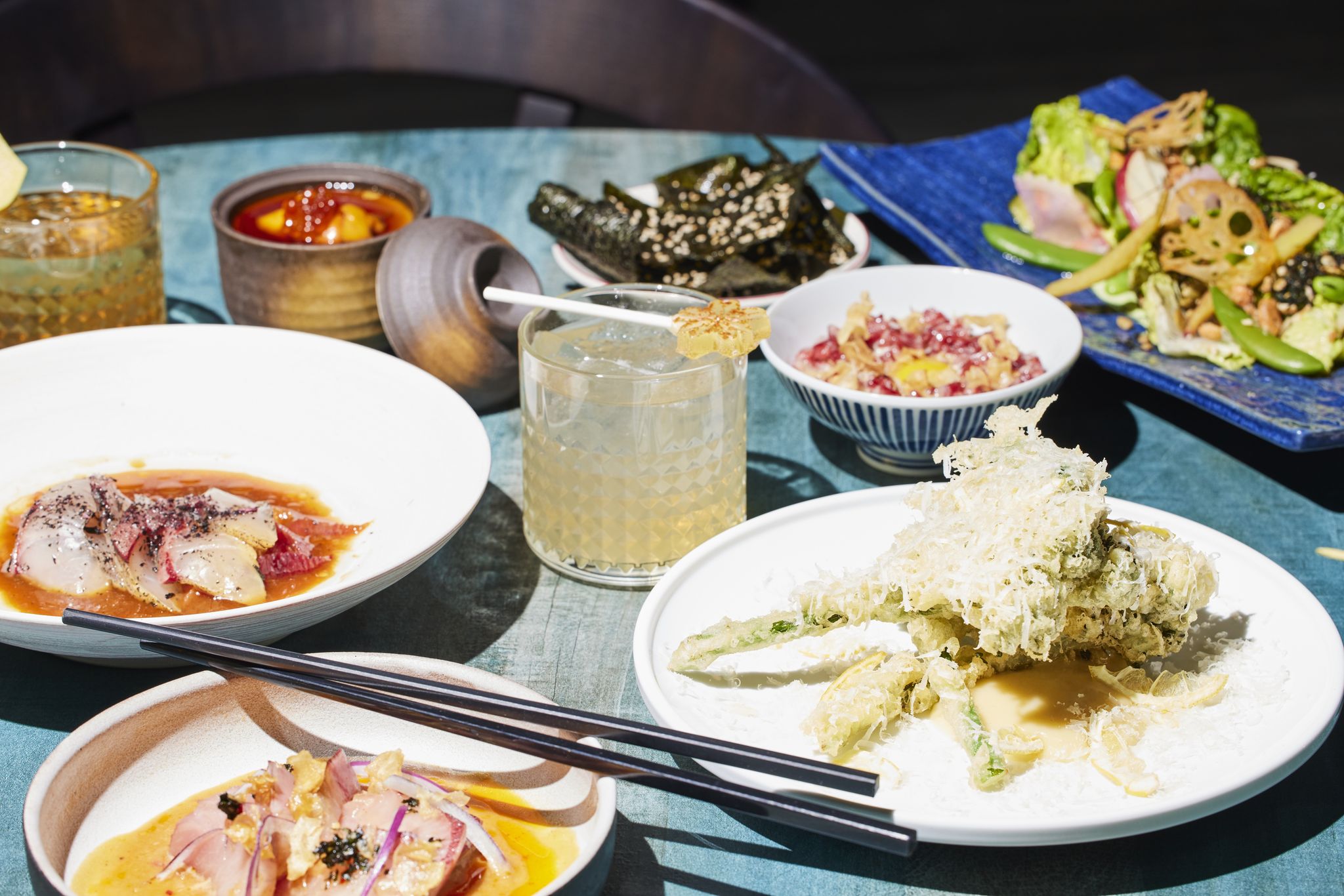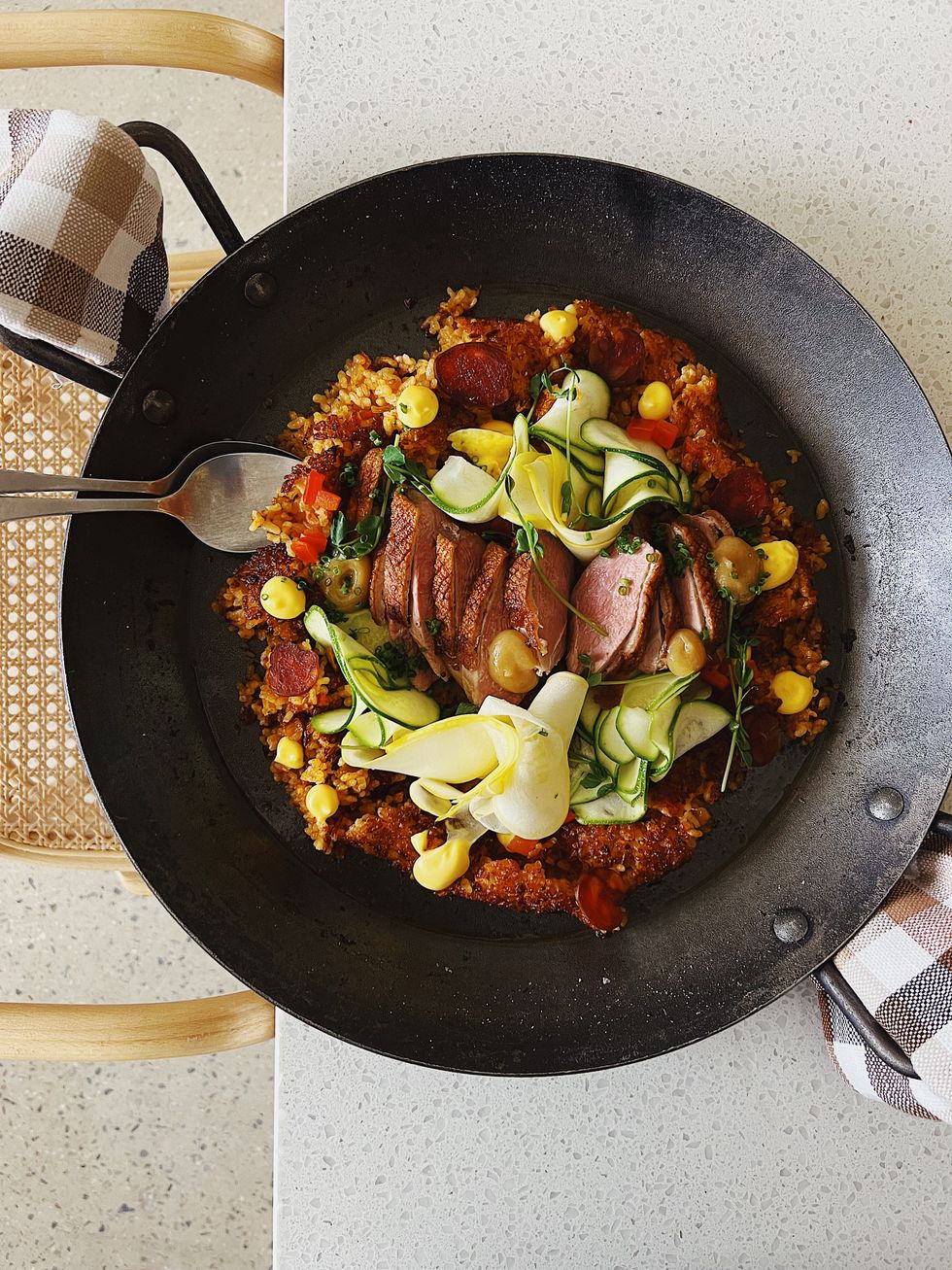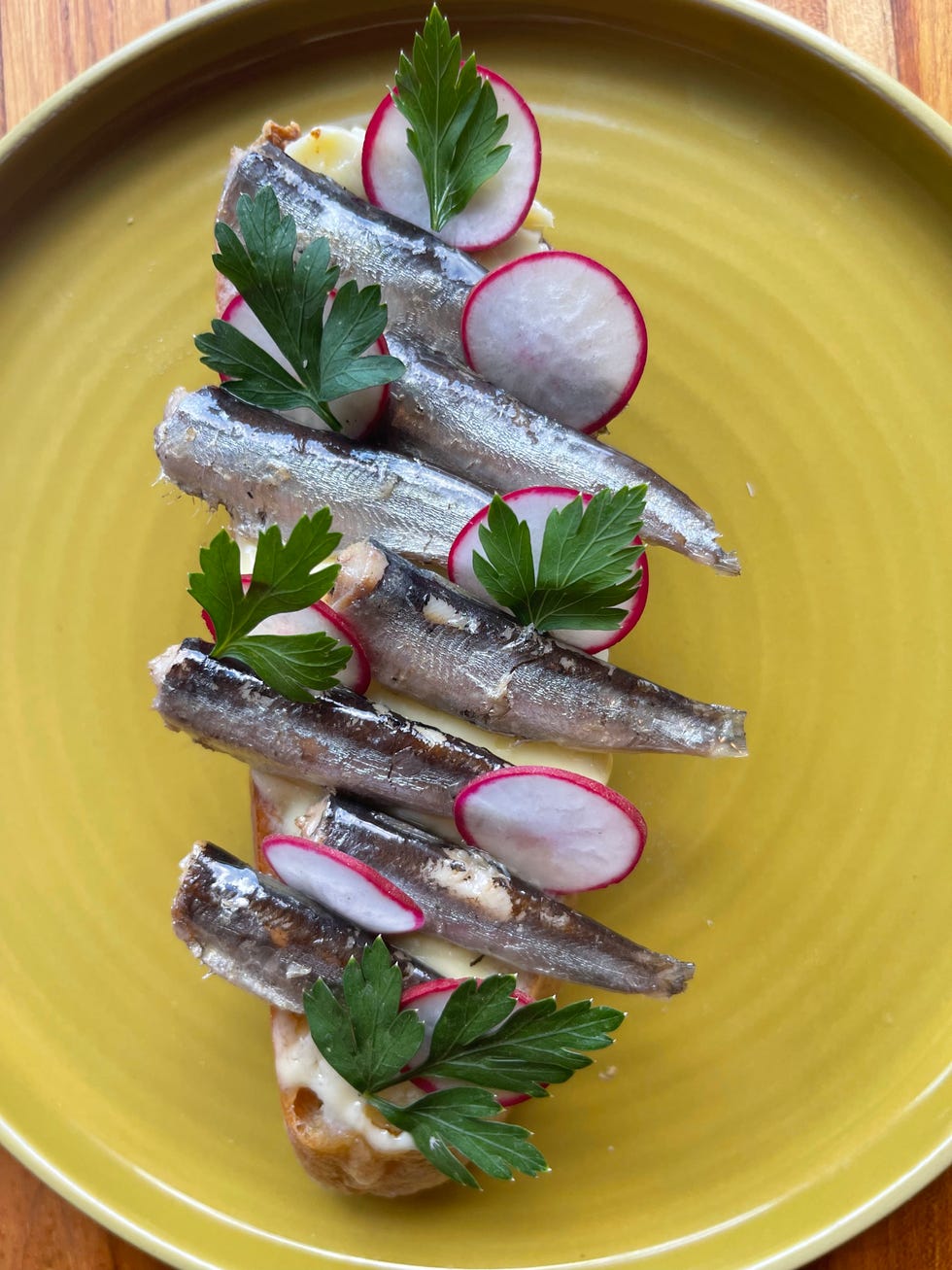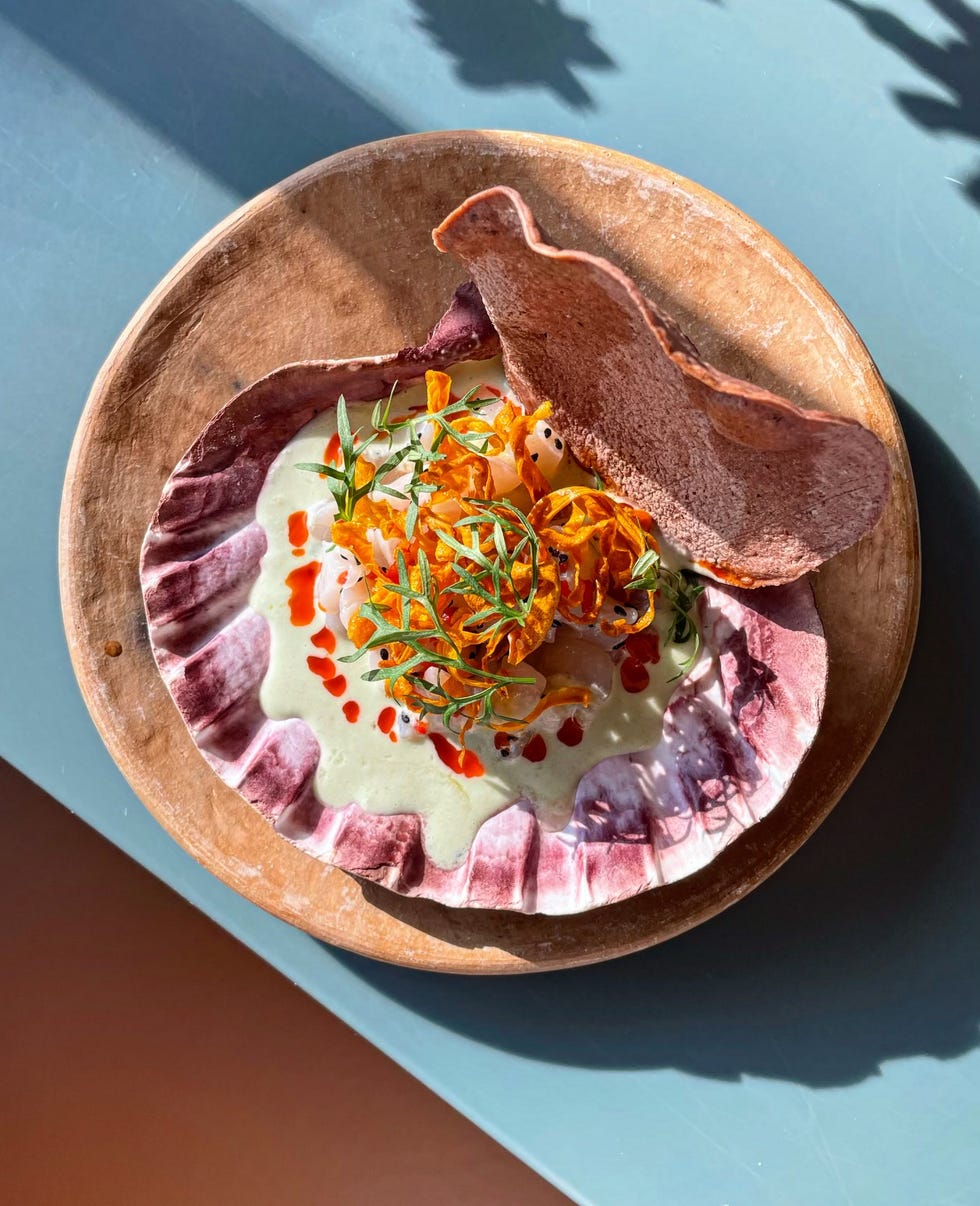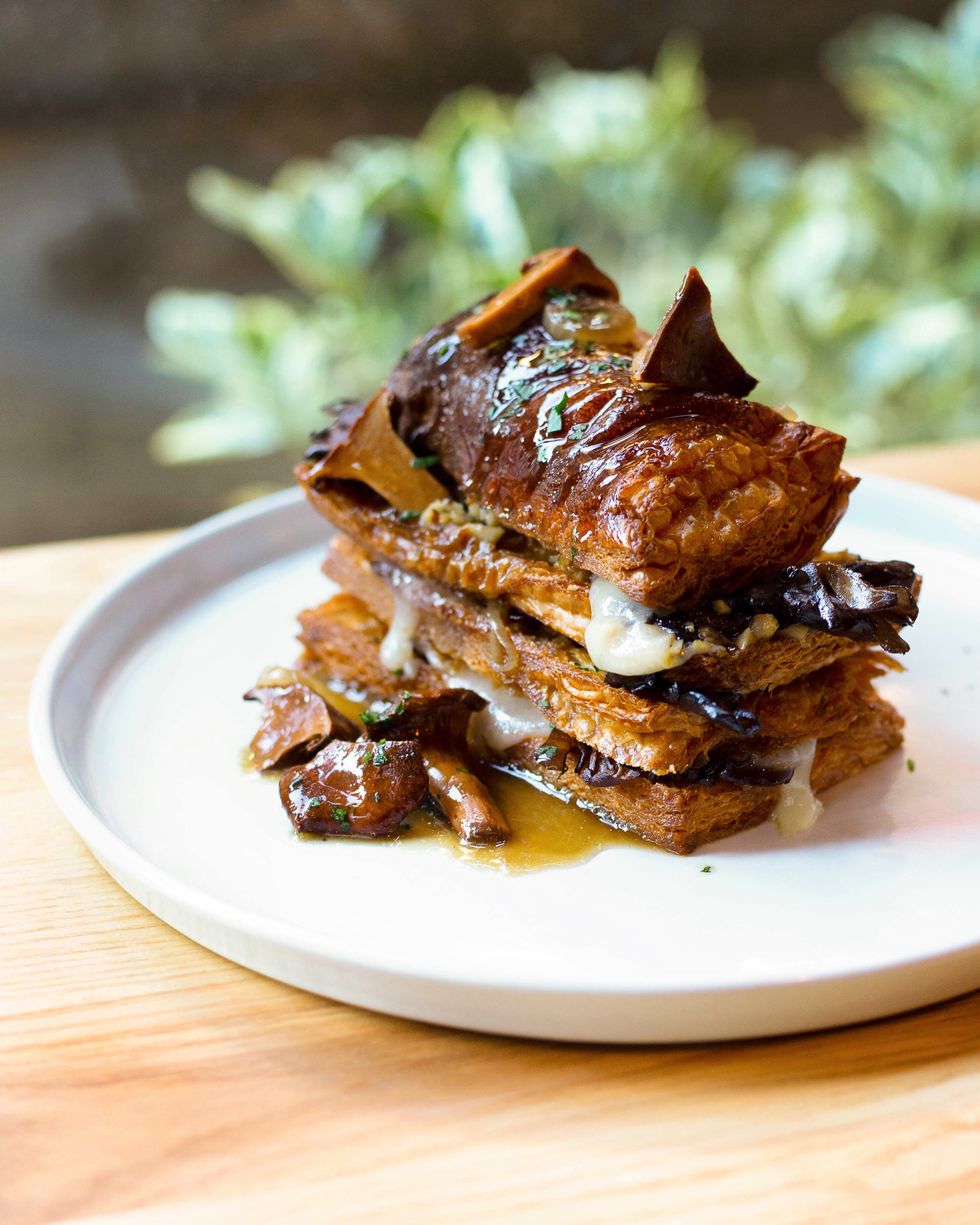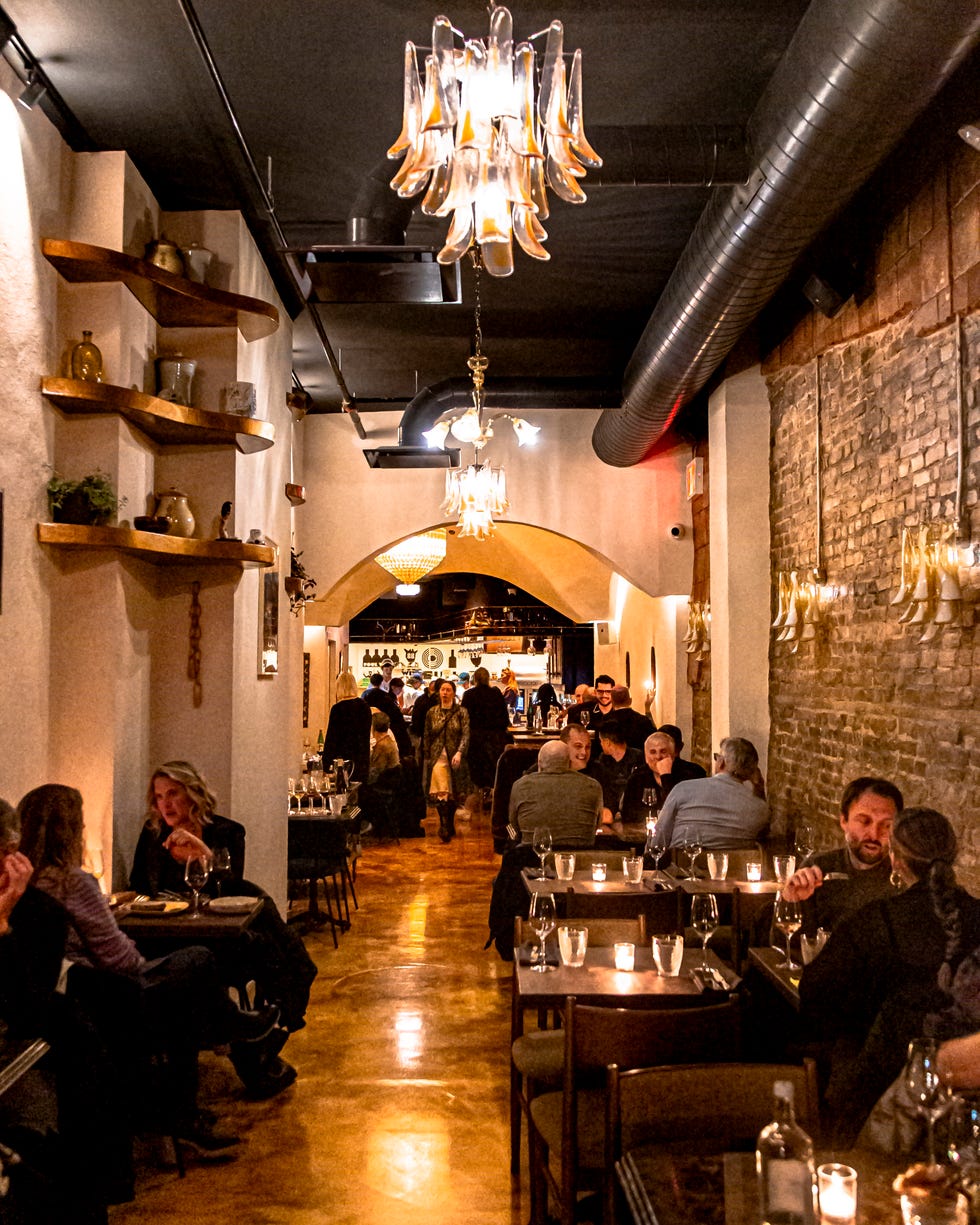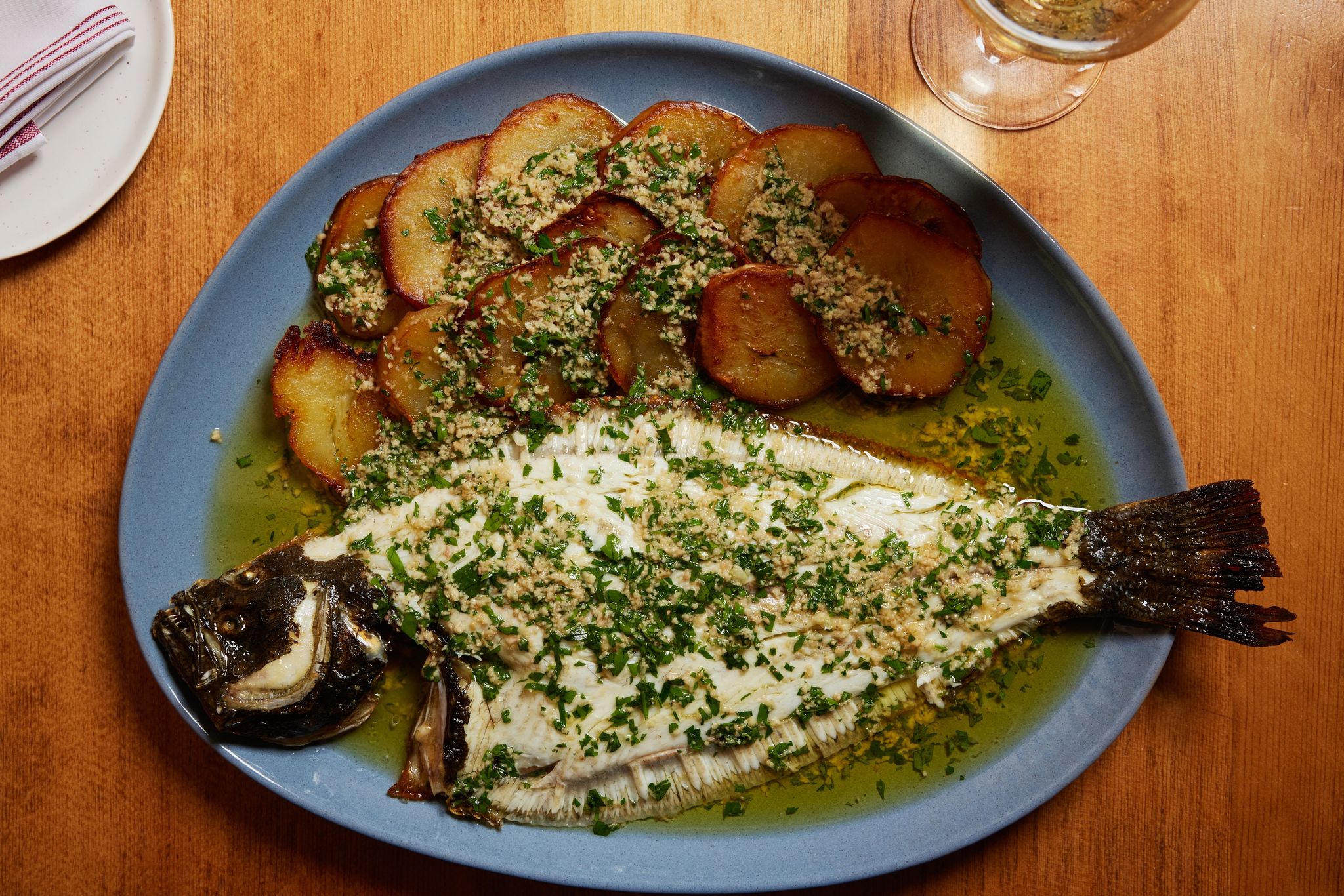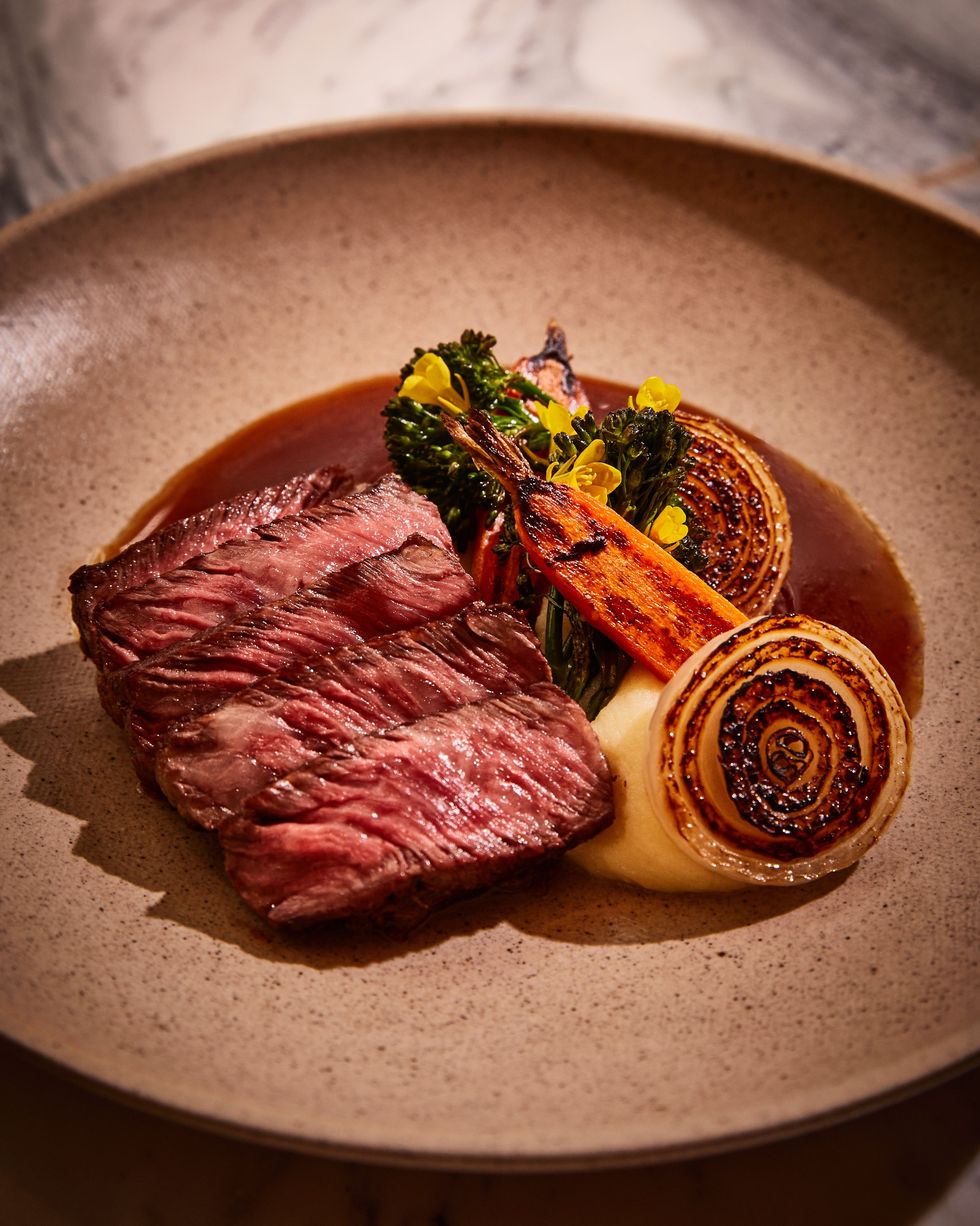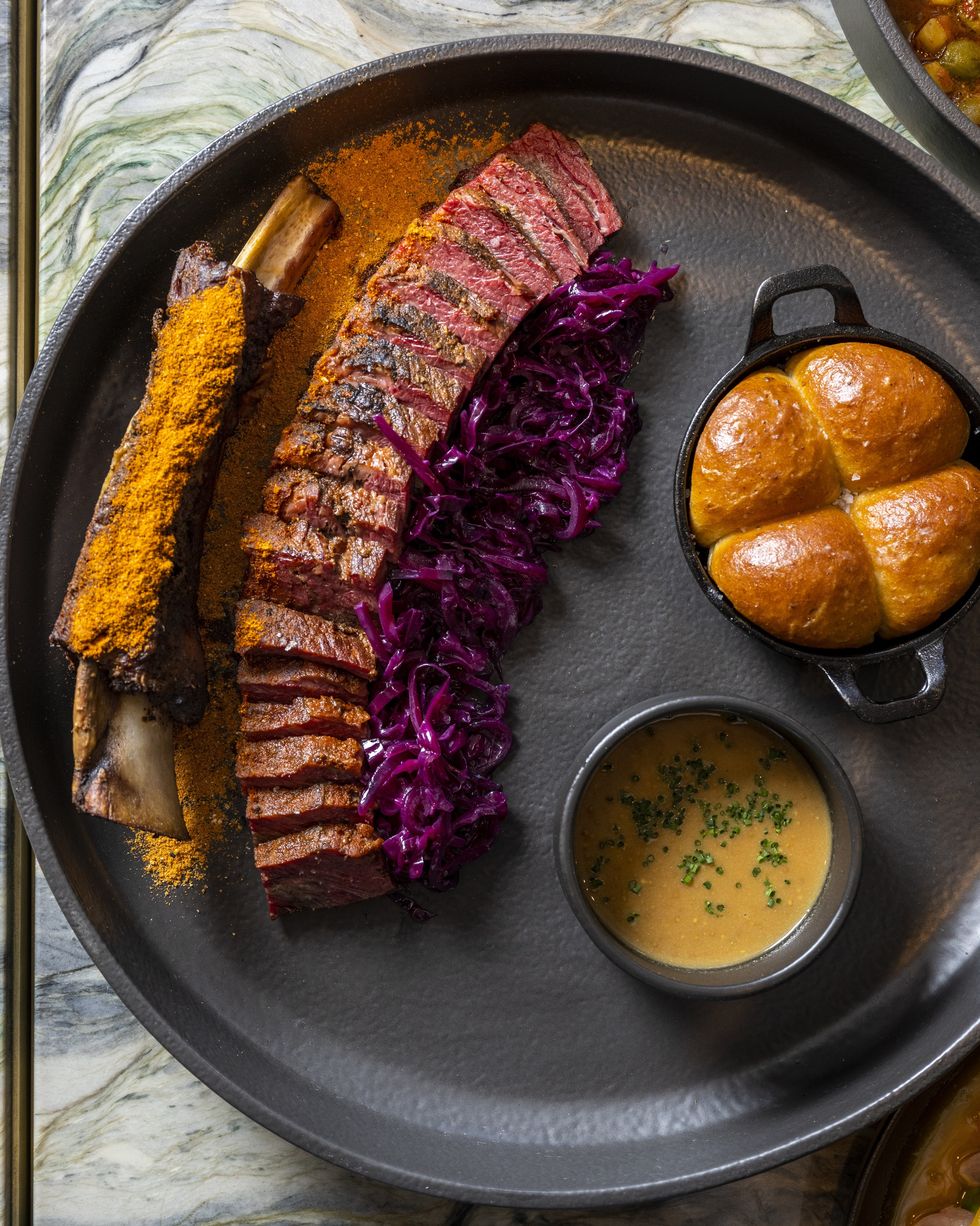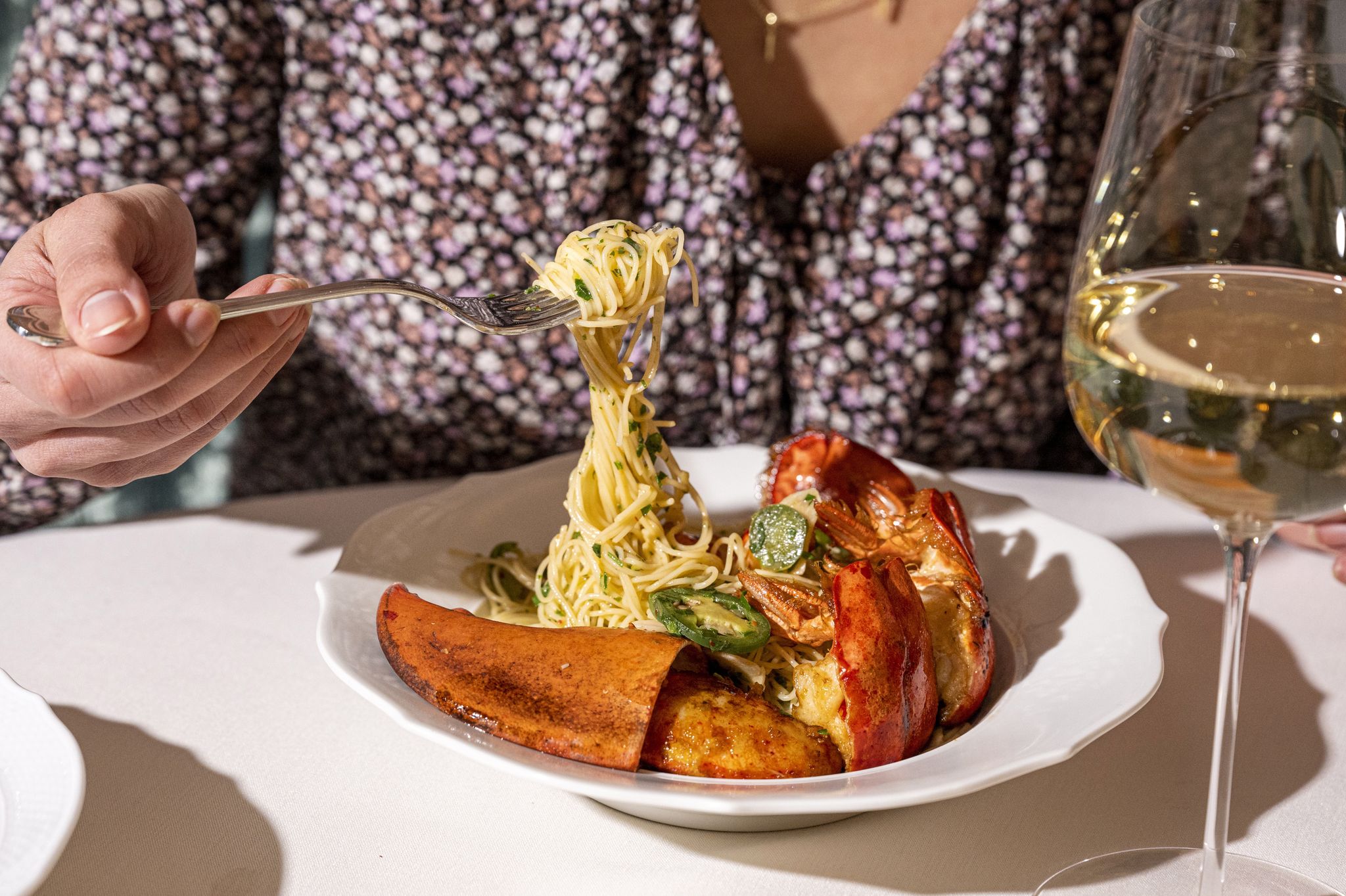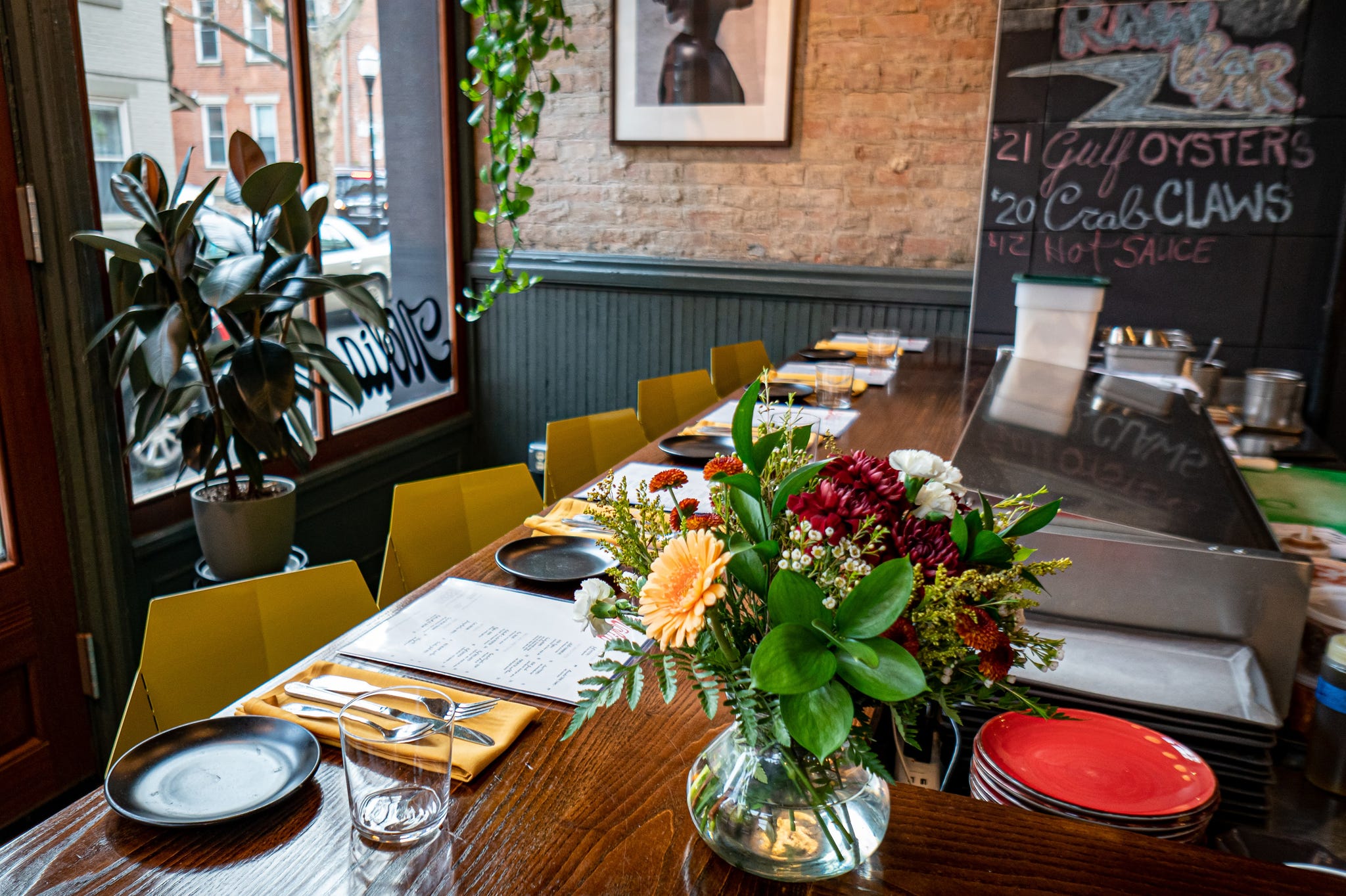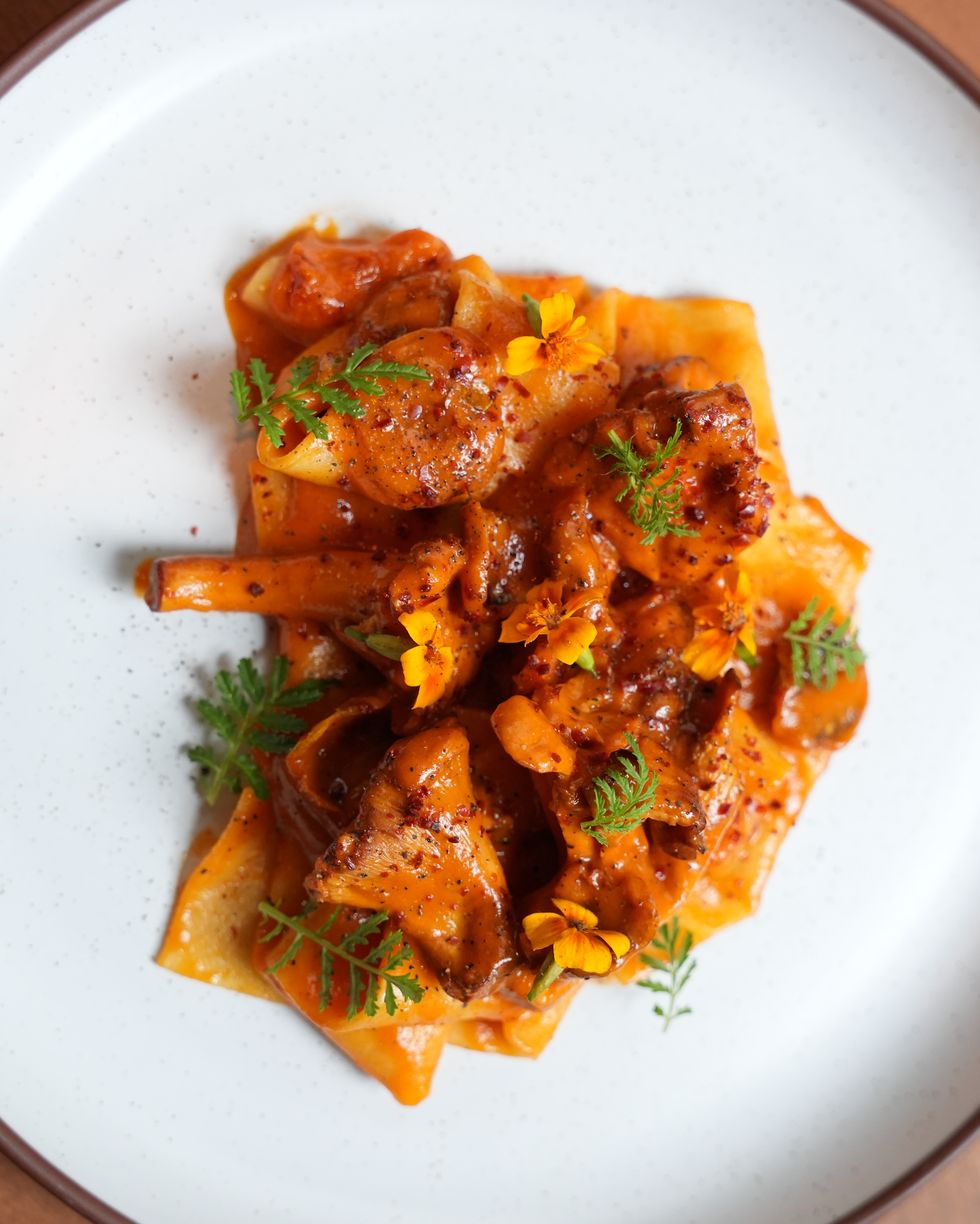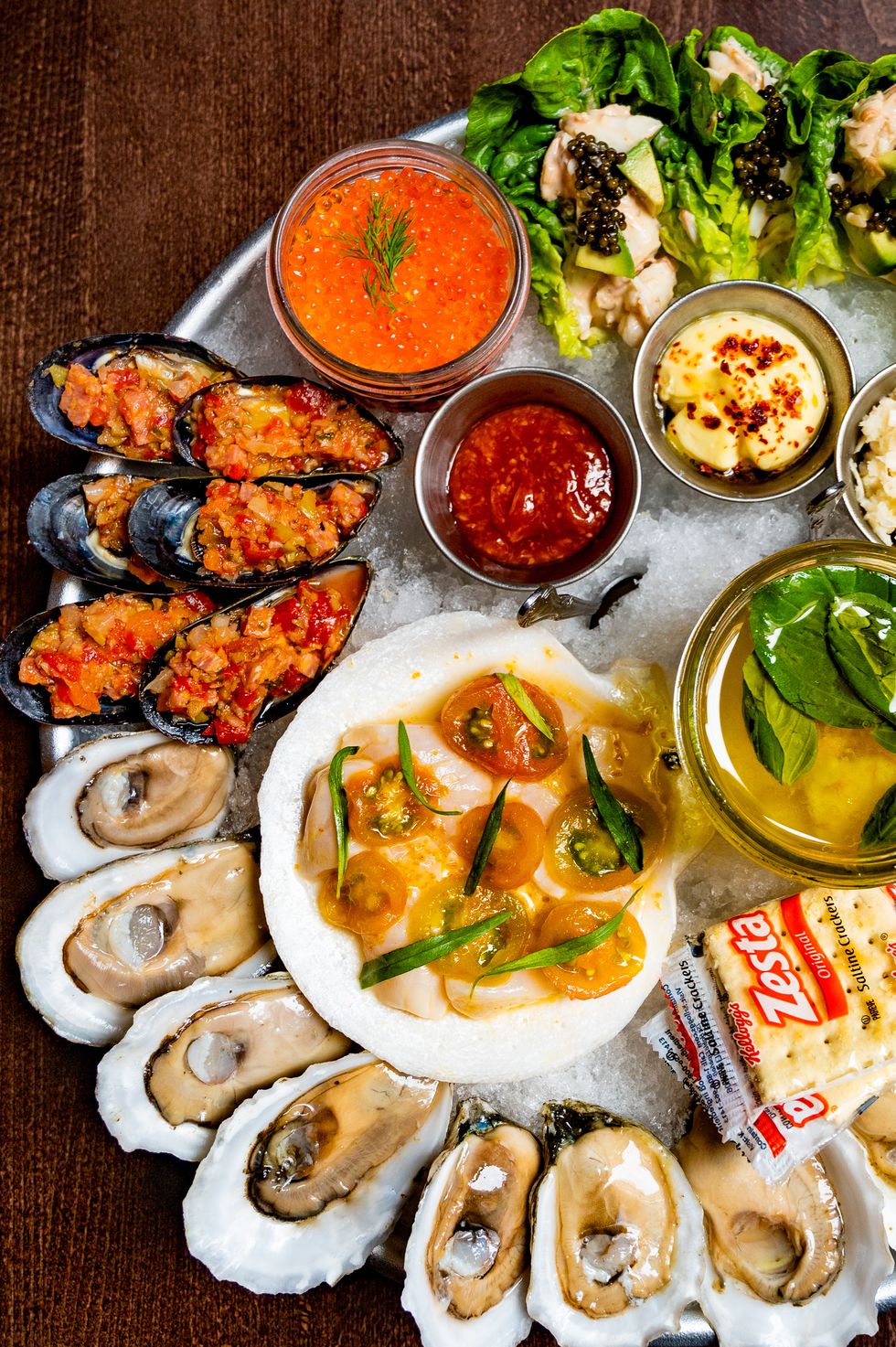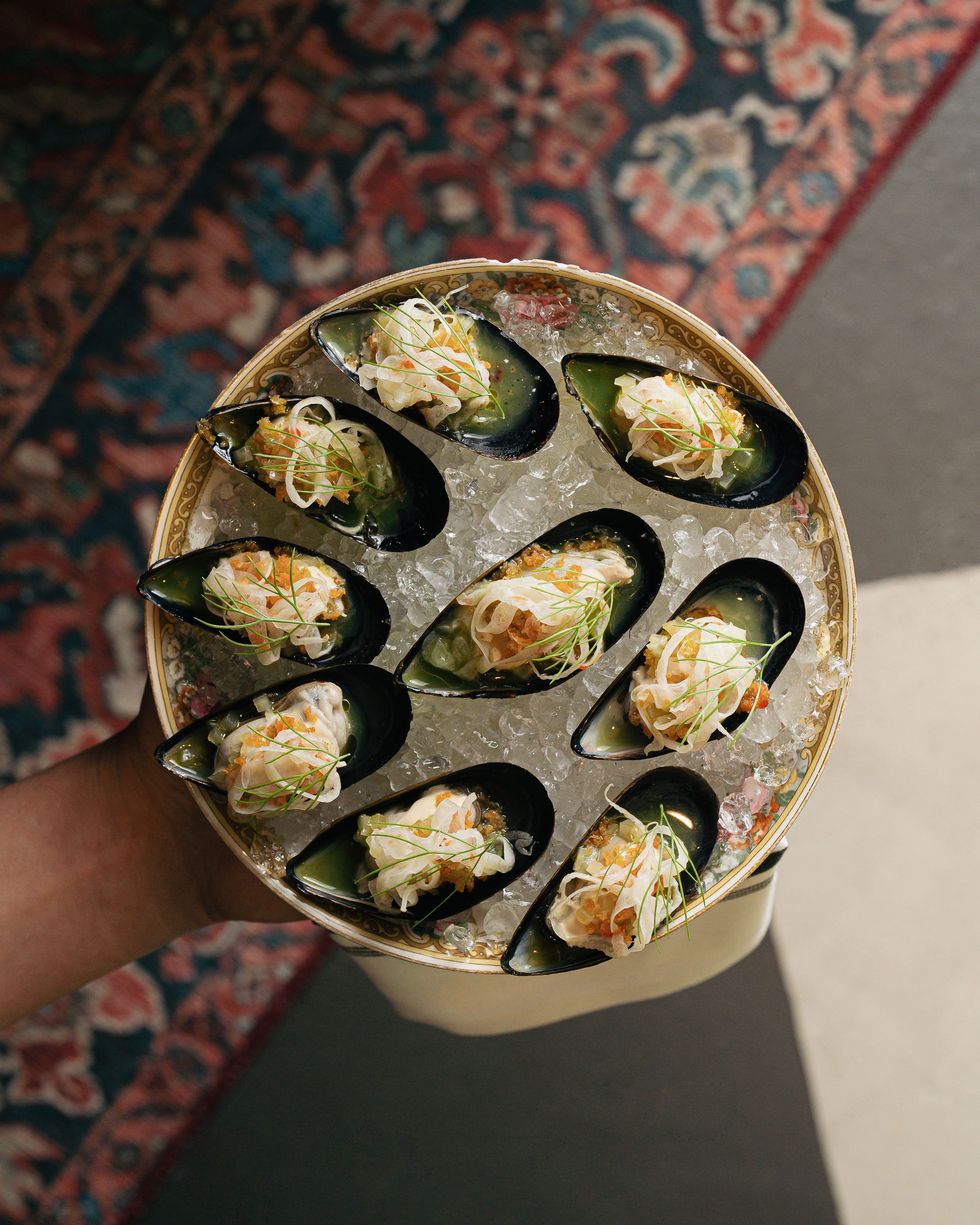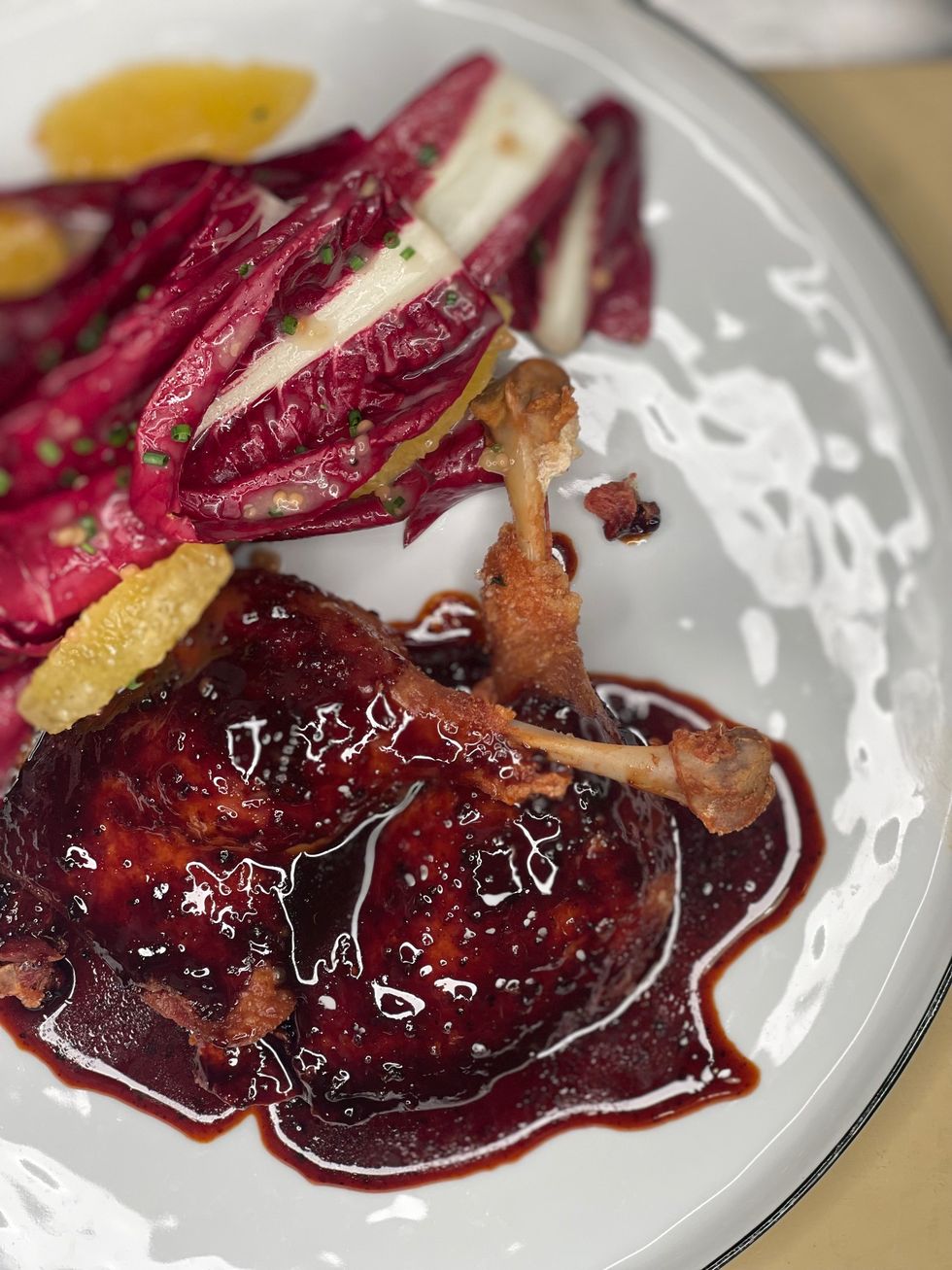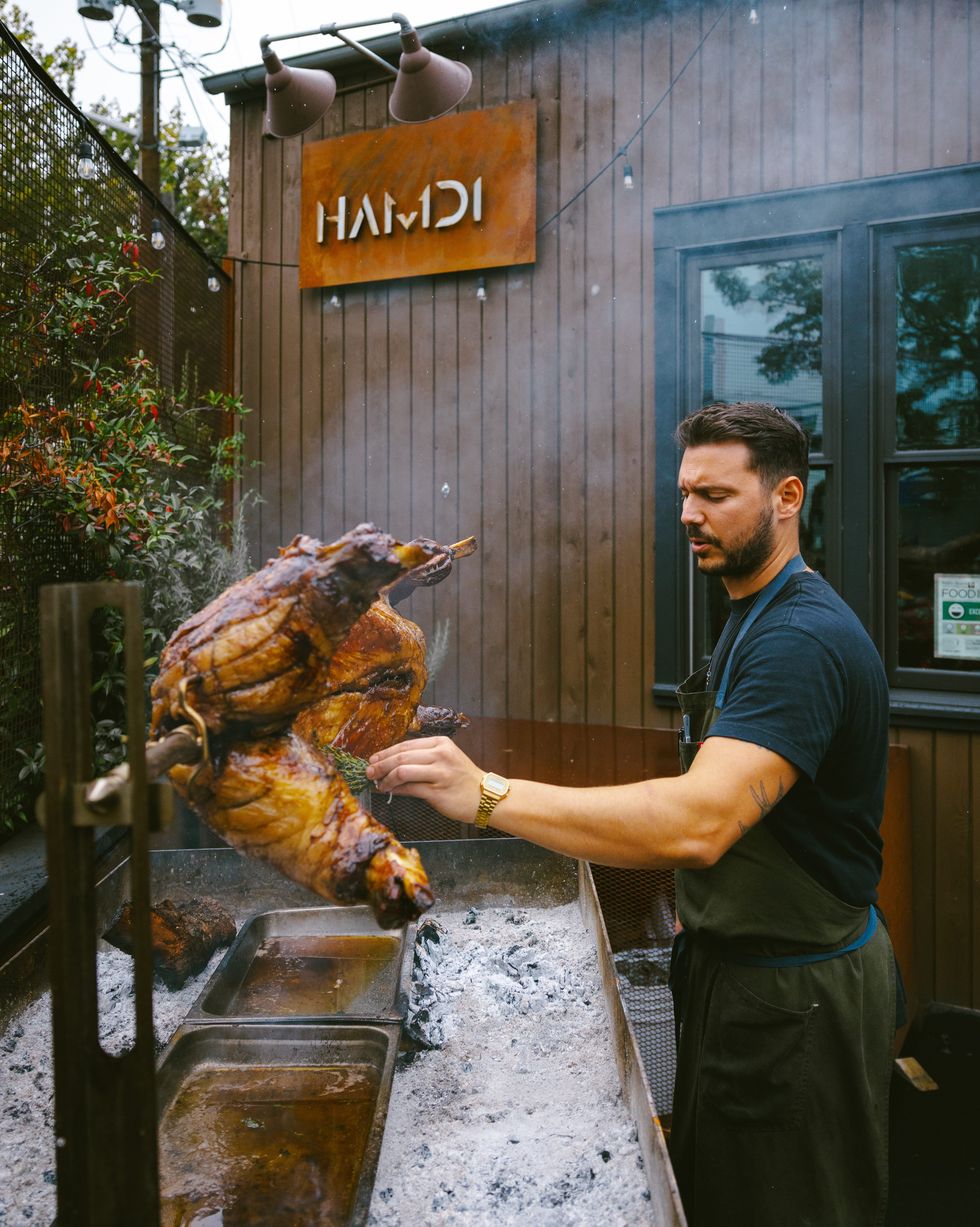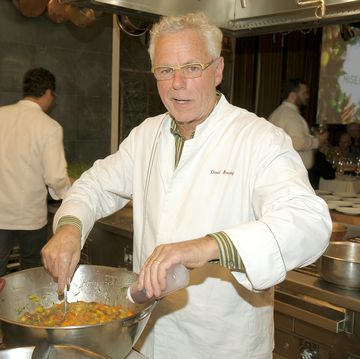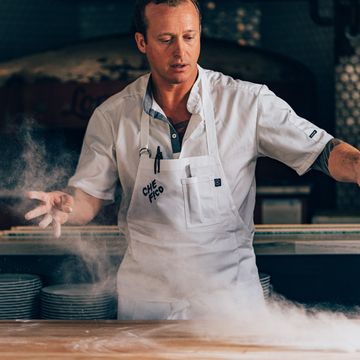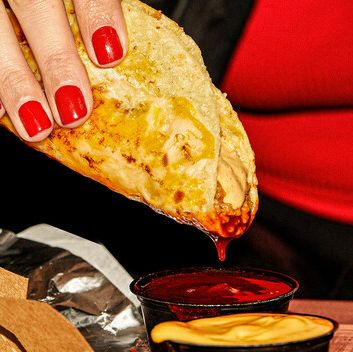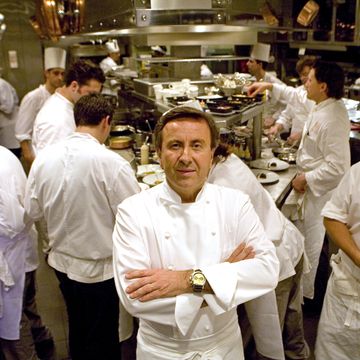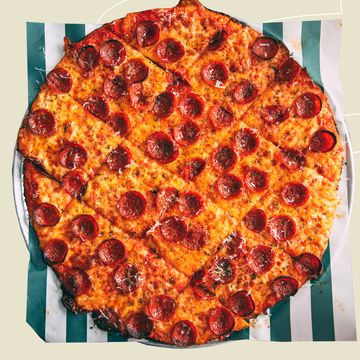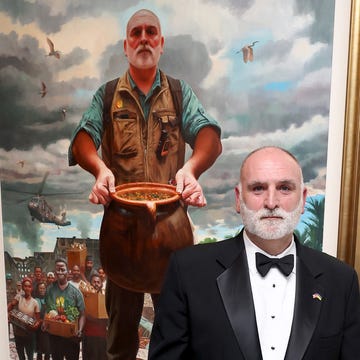Realness can be thrilling. And fortunately, radical authenticity is surging in the world of American dining. Perhaps chefs are becoming braver and more willing to put their personal stories on the plate. Or maybe there’s an unconscious impulse afoot to fend off the existential threat of artificial intelligence and virtual worlds. Whatever the reason, we’re all the beneficiaries of a culinary moment that revels in raw honesty. The collective dining experience right now is visceral, vulnerable, downright weird at times—and so very human.
Nothing is more real than a whole fish, a dish that makes an appearance, in various forms, on many of the menus featured in the forty-first edition of our Best New Restaurants—reported, as always, by real humans: Jeff Gordinier, Joshua David Stein, Omar Mamoon, and yours truly. Over the past year, we crisscrossed the nation, sampling some two hundred new dining establishments that serve almost every conceivable type of cuisine. After a series of spirited debates, we settled on fifty restaurants that stood out from the rest, below, in alphabetical order by state.
Get unlimited access to Esquire's Food & Drinks coverage.
Join Esquire Select
At our Restaurant of the Year, Ilis in Brooklyn, which kicks off our list below, they prepared the fish as it would have been done centuries ago, wrapped in bark and cooked over flames. Across the country at Poltergeist in Los Angeles, they gave us a wild, experimental take on the fish taco, which was dipped in masa and fried. Both felt genuine, and each was delicious.
Honest innovation doesn’t always work in the kitchen, but when it does, it’s like rocket fuel for the soul. You leave not just full, not just filled with delight, but with a spark. It’s a rare thing, but it’s worth chasing. Consider this your map. —Kevin Sintumuang
RESTAURANT OF THE YEAR
ILIS
Brooklyn, New York
You could sell the idea of Ilis on pedigree and ambition alone. Mads Refslund, a cofounder of Noma, the mothership of New Nordic cuisine and an apex of luxe dining, bases his dream restaurant on a concept he’s been incubating for nearly a decade: Locally sourced ingredients are graced by either the fire of burning wood or the raw coldness of ice. (“Ilis” is a mashup of ild and is, the Danish words for fire and ice.) It’s how prehistoric humans might have cooked, although a periodic puff of liquid nitrogen may emanate from the kitchen.
Housed in a former rubber factory in Brooklyn, Ilis conjures its magic honestly. Yes, it’s fire and ice, but it’s also nose to tail, smoked and fermented, upcycled and DIY. Between projects, Refslund wrote a book, Scraps, Wilt + Weeds, which reads like a manifesto on keeping it local and using every bit of everything. He practices what he preaches. A sea snail comes with a spoon fashioned from the foot of the snail, a twig, and twine. The bigeye tuna is served atop the spiny dried husk of a sunflower and the whittled stem of the plant with which to stab each slice. “Preservice is like arts and crafts,” our server quipped. All servers are cooks and vice versa, with one staffer switching every few days, which adds to the “gather ’round the counter” energy of the space. There is a tasting menu, but there’s also a choose-your-own-adventure à la carte option and, just starting on Saturdays, relaxed family-style meals.
The smoke in the air, the dried plants on the wall, and the repurposed snail feet at Ilis have a way of making you feel as if you just knocked the mud off your boots and came in from the field. Sustainability is the subtle bass note, less in a “Look at what we can do with beets!” kind of way and more in the simple idea that all you need for a gratifying meal is right outside. This is perhaps best expressed in one of the most rustic dishes on offer: trout, caught in Pennsylvania, smoked whole in the bark of a birch tree, and accompanied by a butter sauce studded with roe from the same fish.
Refslund does not think of Ilis as a New Nordic restaurant. But when asked what Ilis is about, he spells out who he is: a Danish dude who fell in love with New York and has learned a lot from Mexican and Japanese cuisines. While he left Noma long ago and credits René Redzepi for turning it into a culinary powerhouse, there are striking similarities between Noma and Ilis that reflect those between Refslund and Redzepi. The two were roommates. They’re close friends. They believe in many of the same principles. It’s completely serendipitous that while Noma closes, Ilis blossoms. We can’t wait to see how it will grow. —K.S.
CHILTE
Phoenix, Arizona
“Ta’ encendío,” sings Oro Solido over and over again atop an amphetamine merengue beat. It’s on. It’s on. A neon sign shines in the night. And in the old lobby of the Egyptian Motor Hotel, chef Lawrence “LT” Smith brings a carnal joy to new Mexican cuisine with Chilte. A chicken-heart asiento (the drippings of roast—Oaxacan flavor steroids) peeks from the fringes of an hojasanta quesadilla. Jet-black chocolate aguachile pools on a plate, forming a void on which sit perky Argentinean prawns, with a side of beef-tallow aioli. Squid-ink-marbled birria tacos, which LT and his Sinaloan wife, Aseret Arroyo, began selling three years ago at local farmers markets, arrive with the requisite mug of consommé, this one tipped into deranged flavor with miso. Each bite is a wonder. Heat lightning crackles on the horizon. Ta’ encendío, indeed. —Joshua David Stein
LOM WONG
Phoenix, Arizona
The way sunlight hits a glass just so and a rainbow forms. Love between two people who met at the right moment. Sometimes circumstance makes you almost weep with joy. Such is the case with the Moklen sea-bass curry at Lom Wong. The recipe was given as a sign of affection by a village elder from the ethnic minority in southern Thailand to one Alex Martin, co-owner of Lom Wong. He lived in Thailand for fourteen years, where he met his partner (in life and the restaurant), Yokata “Sunny” Martin, whose mother also happened to be a cook of great, though private, renown.
Now the curry—a silken, boldly spiced, black peppery ochre—appears in Phoenix on this revelatory menu. A third of it is devoted to recipes inspired by Sunny’s mother and grandmother from Chiang Rai; these dishes are herby and fine. A third is from central Thailand, including kanom jin sao nam, clown knife fish rendered into tender balls in coconut milk with pineapple, fish sauce, and palm sugar. And a third consists of seldom seen Moklen specialities. Care is equitably distributed.
All the curry pastes are hand pounded, all the coconut milk handmade. It’s an act of love, of passionate cooking. From one angle, Lom Wong is simply a very good restaurant. From another angle—after one or two shots of ya dong, a powerful Thai moonshine—it’s proof of, if not a divine being, then at least the benevolent tilt of the universe. —J.D.S.
AURO
Calistoga, California
Fine dining in Napa wine country is as essential to the experience as a power nap after a day of visiting vineyards. Did you really do Napa properly if you didn’t have some A5 topped with caviar in the evening? While there’s no shortage of places in wine country that will give you the luxe tasting-menu treatment, Auro, helmed by chef Rogelio Garcia, does so with precision and California ease. There is a crudo of dry-aged amberjack with a citrus aguachile, an heirloom-tomato gazpacho with everything-bagel spice, and an amuse of, yes, Wagyu and golden osetra served atop a light-as-air oyster cracker. Garcia, who’s had stints at Napa stalwarts the French Laundry and Cyrus, prepare these dishes along side his team with remarkable finesse. But ultimately, it’s the way the flavors sing that makes you confident you’ve found the perfect place to end the day. —K.S.
BURDELL
Oakland, California
Chef Geoff Davis wants us to reconsider everything we think we know about soul food (it’s not all heavy) and California cuisine (it’s not all figs on a plate). It’s pork neck smothered with wild chanterelle mushrooms. It’s chicken-liver mousse with crispy chicken skin that you slather on a cornmeal waffle—a play on chicken and waffles. The “barbecue” shrimp with brown butter and Worcestershire is so umami it’ll have you licking your plate. Combining his fine-dining chops with his interpretation of the nostalgic food of his youth, Davis’s retro-cool restaurant is flipping the script. —Omar Mamoon
CHEZ NOIR
Carmel, California
It’s one thing when chefs tell you they want you to feel at home when dining at their restaurants; it’s an entirely different thing when you literally are. Chef Jonny Black and his wife Monique Black live on the second floor above their restaurant, located in a charming old Craftsman home just off the edge of downtown Carmel-by-the-Sea. They’re throwing a dinner party every night, and you’re invited. The sea-centric, French-meets-Spanish menu changes often and with the season, but skewers of grilled abalone smothered in a funky rich sauce made from its liver, and gildas, with the addition of grilled squid, are two bites that’ll never leave the menu or your memory. It’s as romantic as it sounds. —O.M.
DALIDA
San Francisco, California
At Dalida, located in a beautiful, historic brick building in the Presidio, San Francisco’s gorgeous national park, you’ll find a massive menu that celebrates all cultures and foodways of the eastern Mediterranean and the Levant. Greek pork-cheek souvlaki sits side by side with Turkish çöp sis (short-rib kebabs), while juicy Lebanese meat-stuffed flatbreads are dipped in spicy shatta, a Palestinian fermented hot sauce. Literally break bread with thick, fluffy, steaming pita and dip it into a rich, creamy, smoky labneh. What husband-and-wife co-chefs Sayat and Laura Ozyilmaz are attempting to do is tell the story of an Istanbul that could have been, a world where everyone is welcome and happily coexists. The notion is idealistic—but something to strive for now more than ever. —O.M.
DUNSMOOR
Los Angeles, California
I wish I had more friends in Los Angeles, if only so I could order the entirety of chef Brian Dunsmoor’s menu at his always-buzzing eponymous Glassell Park restaurant. Imagine a group of six gathered around a communal wooden table, in an art deco building, with golden candlelight, and then a feast of Southern-inspired deep cuts that feel like they’re from another time. Bison tartare, laden with sunchokes, smoked trout sauce, and mullet roe. A rainbow trout, kissed by hearth flames and dressed with wild mushrooms, pine nuts, and brown butter. Plus, two mind-blowing standards: a pork and green chili stew and a sour milk cornbread. (If I were dining solo, this would be my meal.) It’s a time-traveling, American heritage fantasy that feels more real than anything Hollywood could ever produce. Time to make some new friends. —K.S.
HITOKUCHI
San Diego, California
Don’t worry. You’re in the right place. From the street, you might see the drive-through for a fast-food spot, but Hitokuchi is squeezed in the back. Pass through the heavy door and you’ll find some of the most exquisite cooking in San Diego’s Convoy District. Chef John Hong does not hold back when it comes to premium ingredients, and the prices reflect that. But his uni-and-caviar dish is a local legend for a reason: Imagine a tower of sushi rice in which each individual grain has been coated in oceanic luxury. —Jeff Gordinier
KILN
San Francisco, California
Deep in the kitchen, at the back of the bare and spare, dark and moody, high-ceilinged, concrete-walled space, chef John Wesley asks himself how much he can do with the absolute least. Like a fillet of mackerel quickly cooked over the hearth until crispy skinned. It sits on a spoonful of a caramel-like concoction made from water and bones reduced over the course of a day. It looks simple, but days of prep and years of experience go into this single dish, along with the other nineteen or so courses. Kiln is a study in restraint and an exercise in fine-dining minimalism. —O.M.
MABEL’S GONE FISHING
San Diego, California
Take Iberian cuisine, give it a touch of the California coast, casually wrap it up in a neighborhood bar and restaurant, and you’ve got Mabel’s. There are surprises to the simplest things. The pan con tomate is made with a rustic grilled sourdough, with the option of boquerones: Do it. The oysters (get the ones from Baja) come with a house-made hot sauce that you’ll want to use throughout the meal.
There are elegant martinis as accompaniment: The Greetings From Palma has a touch of pickled-sea-bean brine. The house mini martini gets fino sherry and orange bitters. And if you’re not in a martini mood, at the very least get a glass of the sparkling Albariño from California’s Carboniste. The nonnegotiable (when it’s on the menu) is the swordfish schnitzel, arguably one of the best uses of the fish ever. Hopefully you saved that hot sauce to go with it. —K.S.
POLTERGEIST
Los Angeles, California
The MIDI blips of retro video games and the fuzz of indie rock are the fitting accompaniment to the stoner-on-acid fun that chef Diego Argoti summons at Poltergeist, inside Echo Park’s bar/arcade Button Mash. Expect fun, not fright, despite the ominous name. The night I went, he emerged from the kitchen wearing a Hello Kitty T-shirt to bring us familiar foods gone gonzo: a Thai Caesar salad fragrant with lemongrass and crowned with croutons remixed as a mountain of puffed rice; Chinese takeout broccoli beef done up as short ribs and oxtail in ravioli; a whole dorade fried in masa, like a fish taco reimagined for a Dalí painting. Poltergeist is haunting, but like Casper the Friendly Ghost, you’ll want to hang with it. —K.S.
RORY’S PLACE
Ojai, California
The air is soft in Ojai, a fastidiously chill community about twenty miles inland from the shoreline of California’s Central Coast. It calms your nerves. If there is noise, it seems to get wicked away by some kind of invisible sound sponge so that your weary ears can relish the silence. As the sun goes down, pink light glows on the Topatopa Mountains, and the local gentry come ambling into Rory’s Place for avocado salads and golden tangles of fries and towers of Channel Islands seafood. The food is a bit French, a bit Italian, a bit Cape Cod, and yet 100 percent Californian.
The sisters who run the place, Meave and Rory McAuliffe, understand all that jazz about terroir: You could write a West Coast tone poem by assembling the names of ingredients from their menu (sage, olives, tangerines, fennel pollen, anchovies). But they also understand (more than five decades after the debut of Chez Panisse, up north in Berkeley) that the concept of California cuisine has very little to do with mission statements and a whole lot to do with how a place makes you feel. If you can’t relax at Rory’s Place as the sunlight fades and the air in Ojai gently cools, we’re not sure what’ll do the trick. — J.G.
UBUNTU
Los Angeles, California
Shenarri Freeman, our Rising Star chef of 2021, made a name for herself serving vegan soul food at Cadence in New York. With her second restaurant, she applies her talent for creating craveworthy plant-based dishes to the broad cuisine of West Africa. That means fragrant, spicy jollof arancini; luscious grits made from the African heritage grain fonio; and, the home run, a comfort food that you’ll wish you could’ve eaten every day after school: a riff on the Nigerian meat pie made with lion’s mane mushrooms and dipped in tamarind applesauce. —K.S.
VALLE
Oceanside, California
Being right across the border from Mexico means San Diego is rich in wonderful, traditional Mexican food. Which makes it all the more exciting that Valle is nothing like most Mexican restaurants you’ll find in this part of California. It takes a modernist yet still fun and soulful approach to the cuisine, specifically of the valle in its name, the Guadalupe Valley. (Which is also where the most dynamic wines on its list come from.) Chef Roberto Alcocer’s tasting menu is one of poetic riffs on the essences of Mexican cooking: You’ll get the heavy smoke in a deeply charred caramelized-onion tart, blacker than black, with a glistening quenelle of Kaluga caviar on top. And a chayote in the shape of a rose, with shiso leaves atop crab and a bright-green aguachile, is the essence of surf and turf in Baja. —K.S.
YESS
Los Angeles, California
It’s a cliche to refer to restaurants as “temples,” but Yess actually feels like one, with its beamed ceilings and hushed sonics, its white-robed servers and metal pots that emit fragrant steam and smoke like a sort of culinary incense. As chef Junya Yamasaki stands behind a counter and cooks with priestly vigilance, he looks like a man who can perform miracles, and he kind of does. In early July, you might get a plate of tempura-fried anchovies, followed by a bowl of hyper-fresh stone fruits. A month later, the menu will have changed. Yamasaki listens to the seasons, and you should listen to him. —J.G.
SAP SUA
Denver, Colorado
After work, Ni Nguyen's mother, Hien, was exhausted. Her son remembers the simple dinner she would prepare: boiled cabbage with fish sauce and egg-yolk dressing, a dish called bắp cải luộc. Let Sắp Sửa, the restaurant that Ni and his partner and co-chef, Anna Nguyen, just opened, be a comfort to working parents: Every humble childhood memory could hold inspiration. This classic Vietnamese dish is transformed into a confited cabbage that, like the rest of the menu, is handled with brio and love. They’ve made their moms proud. —J.D.S.
ERBA
Miami, Florida
There is a grandness to the room at Erba. It makes you want to settle in for the evening and bathe in the lushness and the hospitality from chef Niven Patel, partner Mo Alkassar, and their gracious team. But it’s the Florida-tinged Italian cuisine that will make you a regular. Handmade mafaldine mingles with Bahamian conch. The tiramisu gets a touch of tres leches. The crudo is made from local wahoo and topped with fresh star fruit that was plucked earlier in the day at Rancho Patel, chef Patel’s farm, located a short drive away. There is an intense respect for ingredients that shines through in his cooking. The steamed green millet at Ghee—Patel and Alkassar’s Indian restaurant—is a prime example of how a humble thing can be made transcendent. We all know that the greatest Italian food is simplicity squared. Erba offers that, and so much more. —K.S.
MATY’S
Miami, Florida
Raw-fish small plates like crudos are lovely, but they’ve become ubiquitous. They appear on many upscale-restaurant menus as a fine supporting player, but they’re rarely the thing you write home about. That’s not the case at Maty’s. Chef Valerie Chang’s ceviches and tiraditos, a Peruvian dish in which fish is sliced sashimi-style and dressed with vibrant sauces, is like going from a 3D theater to a 4D one, where objects fly at you, the seats rumble, mist fills the air, and for those brief moments you are in another reality. Ocean trout takes on the tropics with a passion fruit, each bite topped with sliced gooseberries; slices of kanpachi are artfully layered with kohlrabi, a kiwi berry, and a bright, fiery aji dulce sauce. You could order everything from this part of the menu and leave happy, but you’d be remiss to not get the choclo. Made with sweet corn, pecorino, and a spicy Huancaína cheese sauce, it’s as addictive and comforting as the very best mac and cheese. And Wagyu oxtail saltado? My goodness. The gorgeous contrast between crisp potatoes and unctuous oxtail is a different level of unreal. —K.S.
MUJŌ
Atlanta, Georgia
All wars are wars of resources, and all sushi-ya exist by the grace of logistics. J. Trent Harris, the young chef who spent years at Sushi Ginza Onodera in New York and Tokyo before opening the fifteen-seat omakase restaurant Mujō, credits the Atlanta airport for the sterling ingredients. Hairy crabs, delivered live from Hokkaido, are split open, their meat mixed with tuna-infused sauce in an early-meal zensai. As a practitioner of Edomae sushi, Harris isn’t trying to reinvent the wheel with his nigiri but rather ensure its smooth revolutions. Hues range from sunset-colored akami to marigold uni. As each morsel is plucked from the plate, it’s like an intimate exchange at the end of a very long trip. —J.D.S.
GIGI’S ITALIAN
Atlanta, Georgia
A small restaurant, like a short story or a poem, can contain an entire world. Not everything will be present, just enough of the right things to make it feel whole. Think of Gigi’s Italian Kitchen, a scant thirty-seat storefront in a small strip of stores in Candler Park, as O. Henry’s version of a red-sauce joint.
Gigi’s has been called the anti-Carbone. The menu, executed by Jacob Armando and Eric Brooks, leaves little room for choice. Two entrées, one pasta, a salad, a beef carpaccio, polenta with caviar, crème fraîche and trout roe (this is, after all, 2023) and a tiramisu. Basta così. Brooks and Armando are virtuosic, indeed obsessed, in execution. On one evening, the constantly changing pasta dish consisted of lion’s mane mushrooms, treated as an osso buco and tossed with homemade rigatoni, while the entrée, a fried, then yakitori’d duck leg, glittered appealingly in an orange marmalade agrodolce atop local okra. The food puts you in such good humor that you can’t help but make friends and end the evening sharing slugs of amaro passed down the bar by once and future strangers who, for tonight, are your paisans. —J.D.S.
NAMI KAZE
Honolulu, Hawaii
The word brunch gives me agita, but if more brunches were the kind of Hawaiian-Asian-meets-mainland-diner mashup that chef Jason Peel puts out at Nami Kaze, I could be a brunch person. Let’s talk about the shrimp toast Benedict. A bowl of hollandaise sauce with a medium sous vide egg comes out; you are instructed to swirl the egg and then dip finger sandwiches of perfectly poached shrimp into it. After one bite, regular eggs Benedict makes zero sense. This is the move. Or the honey walnut shrimp and waffles. There’s no better way to refuel after a morning on the water than an afternoon here. —K.S
ASADOR BASTIAN
Chicago, Illinois
Stepping inside the elegant four-story townhouse that Asador Bastian is ensconced within feels like trespassing, but any impostor doubts subside once an ice-cold martini is handed to you in an oversized shot glass. Chef Doug Psaltis and co-owner Hsing Chen’s place is sneakily one of the most exciting steak joints in America. In the Basque tradition, it specializes in older cows, whose meat is complex and worth savoring and sharing, if only to save room for risotto-like arroz cremoso. You would be equally happy if you left without eating any beef. But don’t do that. —K.S.
WARLORD
Chicago, Illinois
So why name your restaurant Warlord? “Because every night, we’re going to war,” says the chisel-cheeked, mustachioed chef, dressed in all black, while the flames from the hearth rise up behind him. Earlier that day, he took one of his cooks to the emergency room—he had gashed himself in the middle of prep. Two of his cooks called out sick. And yet said chef, Trevor Fleming, alongside his comrades Emily Kraszyk and John Lupton, is going to battle every night until 1:00 a.m., even on Mondays. This is a late-night spot, for the industry, by the industry. It’s loud. It’s packed. It’s rocking. Sit at the counter and watch the magic that happens when fire meets meat. Order as much as you can stomach, and definitely get the foie gras—it’s basted in butter and sugar so it achieves a candylike shell, and it’s served with slices of chewy, smoky, vinegary marinated green tomato slowly dried over the hearth. —O.M.
NAMI
Louisville, Kentucky
Before Edward Lee was Louisville’s most famous chef, he opened Clay, a Korean restaurant in New York, serving pajeon, kalbi, miso quail with oranges, fish-sauce salmon with papaya. Since then, he’s brought gochujang to the South at 610 Magnolia and Milkwood but never as explicitly. At Nami, Lee has returned to his roots, more seasoned and right on time.
Hansik, or Korean cuisine, is peaking, and Nami’s menu—long-marinated meats with a retinue of banchan, inky jajangmyeon (delightfully complemented by broccolini), a rosy quenelle of beef hwe atop crispy veg-stuffed pajeon—might be familiar to anyone who’s eaten in K-Town. But Lee’s deep knowledge, invention, and skill—good examples are the crystalline fried chicken atop fiery tteokbokki and the quenelle of gochujang butter accompanying the tuna tartare—as well as the sure hand of Yeon-Hee Chung, a Louisville halmoni whom Lee has brought on to run the jangs and ferments, mean Nami delivers a deeply satisfying gamchilmat, the profound flavor that Louisville’s been missing. —J.D.S.
DAKAR NOLA
New Orleans, Louisiana
A meal at Dakar NOLA comes with stories. With each course of the tasting menu, chef Serigne Mbaye exits the kitchen to address the room. He’ll tell you about the meaning of the traditional Senegalese handwashing ceremony that kicks off the meal, how the origins of gumbo and étouffée are rooted in West Africa, or how his black-eyed-pea stew—perhaps the most profound dish on the menu—was inspired by the rich, palm-oil-laden food that was fed to the enslaved to fatten them during the Middle Passage. All of this happens in the front room of a traditional shotgun house, which makes the night feel like a dinner party that is as enlightening as it is fun. —K.S.
HUNGRY EYES
New Orleans, Louisiana
Eating at the eighties-themed Hungry Eyes feels like you’ve stepped into a music video by Duran Duran. The Patrick Nagel pop art on the walls, the pink neon glow from the mirror behind the bar—it’s lit. Literally. The team has cooked up a lively, stonery DIY dinner menu. Save the garlicky toum dip that comes with your fries, order a side of roti, and make fun sandwiches with the pastrami, which is grilled until crispy on the outside. Who does that? The same folks who brought you NOLA’s stoner darling, Turkey & the Wolf. —O.M.
LEHRHAUS
Somerville, Massachusetts
I’ve been to thousands of restaurants in the past couple of years, but I hadn’t truly felt at home until I walked into Lehrhaus, a Jewish tavern and house of learning. Maybe it was the Lactaid dispenser. Maybe it was the mural of Leonard Cohen above the hand dryer in the men’s room. Or the conversation at the bar: Henry James on one side, refundability of plane tickets to Miami on the other. Could have been the Samsonian bartender’s “Nazi Lives Don’t Matter” T-shirt or the mensch-seeks-mensch meetup in the library. More than likely it was the food—chef Alex Artinian’s and chef Noah Clickstein's celebration of Jewish diasporic cuisine. Both Ashkenazim and Sephardim are represented. Deviled eggs, haminados-style, are aged in coffee and topped with pickled mustard seeds. A herring tartine comes with the bright spice of pickled peppers alongside the silvery fish. A golden fish-and-chips made with day-boat-caught pollack and accompanied by amba vinegar, a s’chug aioli, and Old Bay seasoning seems secular. But as the Talmudic menu informs, Old Bay was invented by Gustav Brunn, a Jewish German refugee, in 1939. It is both delicious and a revelation. —J.D.S.
SADO
St Louis, Missouri
Chaos is the groundwater from which Nick Bognar springs. His new restaurant, Sado, a follow-up to the 2020 Best New Restaurant Indo, has all the decorum of a rugby scrum and all the cakewalk swagger of a victor. Typically, a sushi chef is a game-faced control freak. But Bognar, hair in a top knot and bandanna’d, works behind the sushi bar like a merry ronin. On the diner-thick menu is the brilliant confluence of his Thai and Japanese background. Rose-ombre slices of kinmedai arrive in a Thai kosho and coconut nam plam. A nigiri of nodoguro (blackthroat sea perch) is blowtorched—which one simply doesn’t do—yet it’s smoky, silken, and brilliant. Plenty of labor goes on unseen (there’s a large kitchen with an area for aging fish), but it’s worn lightly, it's given freely, and its fruits are tasted with joy. —J.D.S.
LITA
Aberdeen, New Jersey
The hearth at Lita sees constant tending with a vigorously waved fan, the feeding of charcoal with a shovel, the movement of chicken and octopus. It is the thing you least expect to see inside a strip mall in central Jersey next to an old bowling alley, but then again, no one expected that a destination-worthy Iberian restaurant would be here. Many things come from this hearth, but the paella beckons. The fire gives it criminally generous amounts of socarrat, the smoky, crunchy, flavor-packed bits of rice that, to many, are the primary reason for the dish’s existence.
But there is depth to Neilly Robinson and chef David Viana’s menu beyond the hearth. Lightly fried pieces of Manchego will make you rethink how cheese should be fried. The tuna tartare, dressed in ajo blanco and jalapeño, topped with roasted almonds, wrapped in a shiso leaf, and served atop a bed of ice? One of the most sublime bites you’ll have this year. The drinks, from Ricardo Rodriguez, have just enough of a culinary touch to swerve along with the food. A boulevardier gets coconut oil; the Spanish martini, a bit of piparra brine and saffron oil. By night’s end, as you step out into the parking lot, you half expect the mosaic sidewalks of Lisbon. —K.S.
CORNER OFFICE
Taos, New Mexico
A decade ago, Zak Pelaccio and Jori Jayne Emde kick-started a culinary boom in New York’s Hudson Valley with a risky, first-of-its-kind restaurant called Fish & Game. Not long after Pelaccio won a James Beard Award, they sold it, quietly moved to Taos, and decided to hit reset. Quirky and shaggy and unlike anything Taos has ever seen, Corner Office is the après-ski lodge of your dreams: a warren for quaffing natural wines and feasting on funky comfort food. You want a frico, which is a potato pancake all gooey with melted Gruyère, and you want the sardine toast that involves sourdough smeared with the hand-churned French butter known as Beurre de Baratte. You want plenty of time, too, because you’ll wind up staying for hours. —J.G.
CAFÉ CARMELLINI
New York, New York
It’s taken fourteen years for chef Andrew Carmellini and his partners at NoHo Hospitality Group, Luke Ostrom and Josh Pickard, to bestow his name upon a restaurant. There were plenty of worthy heirs before—Locanda Verde, Lafayette, and Carne Mare, to name a few. But Café Carmellini, which opened in a family mansion turned hotel on Fifth Avenue, is his true golden son. It’s a grand restaurant, a high-ceilinged sensory casino where everyone’s a winner. The place begs for romance; in its glow, the years slough off, every joke is witty, and every morsel is manna.
Like Daniel Boulud, his mentor, Carmellini has always been adept at striding the line between populism (what the people want) and prophecy (what the people don’t yet know they want). Here he’s a hit man, executing a deeply personal menu with precision and flair. A zingy acqua pazza with kanpachi is as bright and light as a butterfly. A duck tortellini and a lobster-and-caviar cannelloni make the convincing case that all proteins should arrive in freshly made pasta. The sole Normande, one of just a half dozen entrées, comforts me with apples, calvados, and shingles of snowy-white mushrooms. There’s a scallops Cardoz, a delicately spiced tribute to a friend of Carmellini’s, the chef Floyd Cardoz, and a spectacular pistachio gelato. Like any good son, Café Carmellini respects its elders but is carving a future of its own, a bright future indeed. —J.D.S.
CASA SUSANNA
Leeds, New York
The entrepreneurs behind Camptown, a renovated cluster of cabins in the Catskills, could’ve easily opted for a Wet Hot American Summer–themed bill of fare—burgers, hot dogs, s’mores. Instead they trusted chef Efrén Hernández and went with something you’d never expect to find five minutes from the Rip Van Winkle Bridge. Let’s just say it: Nowhere on the East Coast will you have better Mexican food than what Hernández is cooking at Casa Susanna. His menu (the squash-blossom tetela, the mackerel al pastor, the tamal de chocolat) is a moan-inducing marvel. The heirloom corn comes from Mexico, as do the chiles, as do many wines on the wine list. Summer camp never tasted this good. —J.G.
CLAUD
New York, New York
I have two things in mind when I head to Claud in the East Village. First, I’m going to go on a wine adventure, because co-owner and beverage director Chase Sinzer always steers toward the elegant and surprising. And second, I’m going to get what the menu describes, simply, as “red shrimp, garlic, olive oil.” It’s really a kind of magic trick. The shrimp arrives on the raw side, and the heat of the oil and cast-iron skillet cooks it to the perfect bright pink hue. Claud has solved the problem of the perpetually overcooked gambas al ajillo. But then things go a little off script. The chill basement vibes of Claud kick in—it’s like one of those natural-wine bars in Paris or Copenhagen where it seems as if bohemian life can go no higher—and I end up ordering nearly all of chef/co-owner Joshua Pinsky’s menu, from the towering mushroom mille-feuille to the chicken-liver agnolotti to the six-layer devil’s food cake. You know that feeling you get in Europe when you sense that they’ve figured the good life out? You can get that here, too. —K.S.
FOUL WITCH
New York, New York
A crazy name for a restaurant, but it clicks when you eat there. Italian cuisine can be held back by the weight of its own traditions. The team at Foul Witch dares to imagine what would happen if you conjured Italian cooking anew in a stoned brainstorming session. Everything tastes a little funkier. Plums bathe in leche de tigre—the Peruvian elixir that usually comes with ceviche. Branches of chicory get down and dirty with pecorino di fossa—cheese that’s aged in a hole in the ground. There’s roasted goat and grilled tripe and a melty slab of testa. Wait, is this date night or Walpurgisnacht? —J.G.
FOXFACE NATURAL
New York, New York
You could surmise that this idiosyncratic restaurant is the result of combining nearly unlimited capital, thanks to owners Sivan Lahat and Ori Kushnir’s previous lives as tech entrepreneurs, with chef David Santos’s experience in the kitchen of David Bouley, but it’s more fun to simply join in Foxface Natural’s dance at the edge of the possible. Much has been made of the carnivore bravado. So sure, get the tender Boer goat and kangaroo tartare. But the must is a whole fluke, swimming in garlic-and-parsley-studded oil and coins of potato. The menu is pure weirdo joy, a blip in the gray. It’s best just to devour it all. —J.D.S.
OIJI MI
New York, New York
Chef Brian Kim’s Golden-hued Flatiron restaurant is that rare place that’s both delicate and kinetic. On the one hand, the titular oiji bowl embodies hansik’s Confucian harmony of elements, color, and flavor: The sweet shrimp, saline uni, pickled cucumber (oiji), creamy egg yolk, and seaweed rice are a subtle-hued rainbow. On the other, the compressed watermelon with puffed rice, chojang, finger limes, and shiso is a frequency-shifting flavor grenade. High-end riffs on Korean cuisine are, thankfully, no longer rare. But riffs done this well are nigh-on impossible to find. —J.D.S.
TATIANA
New York, New York
We’ve talked about the food. The curried goat patties, the short-rib pastrami suya, those succulent oxtails. Now let’s talk about how Tatiana makes you feel. Because long before this restaurant had its revolutionary debut at Lincoln Center, chef Kwame Onwuachi was involved in crafting every element of the experience, from the menu to the playlist to the design of the space. And what he and his team created is a spot that feels simultaneously exclusive and inclusive. As in: Here’s the best party in the city, but everybody’s invited. In New York, there’s nothin’ you can’t do. —J.G.
TORRISI
New York, New York
The Major Food Group, known for the maximalist red-sauce joint Carbone, swung big with Torrisi. Like the OG location, where it all began in 2009, Torrisi draws heavily from its terroir. But bigger. In a score of dishes, chef Rich Torrisi synthesizes the city into dinner. There’s a glassy-skinned, dry-aged duck on top of a mulberry agrodolce; chopped liver with Manischewitz; an American-ham plate with San Gennaro–inspired zeppole. Perhaps Torrisi will go the way of Carbone, copies across the world. But right now, the restaurant is an exultation of all that the city can be. —J.D.S.
AJJA
Raleigh, North Carolina
That ultra-charred eggplant dip might at first taste like an amped-up baba ghanoush, but after a few bites the tomatoes and spices hit and it seems more like baingan bharta. The smoky lamb seekh kebab? It comes piled on top of a cooling labneh coupled with an acorn squash puree—it’s one part Indian, one part Mediterranean, one part Southern, and all parts delicious. Ajja tells the story of the Indian diaspora through food, blending borders and reminding us that we have more in common than we have differences. There’s no other restaurant quite like Ajja, because there’s no other chef (and musician) quite like Cheetie Kumar—she can shred on guitar and she can cook. Sit outside on the back patio and take in the fun and funky vibe. —O.M.
NOLIA KITCHEN
Cincinnati, Ohio
There’s smoke but little fire in the kitchen at Nolia Kitchen. That’s thanks to a whinging neighbor who forced the chef, New Orleans native Jeffery Harris, to get rid of the outdoor smoker at his small Over-the-Rhine restaurant. (Little do they know, Diptyque’s Feu de Bois candles go for $75.) That hasn’t stopped Harris from bringing the full press of New Orleans flavors to Cincinnati. But this is no bullshit second-line tourist romp down Magazine Street. Harris’s cooking bundles convention and invention into a restless, ever-evolving menu. Crab boulettes sit atop a smoked duck-fat aioli like crunchy snooker balls that yield with a pleasing obeisance. (Sometimes crabs are out and it’s lamb and chicken-liver boudin.) A jerk rabbit, the restaurant’s pièce de résistance, arrives, caught mid-stride, beside a pond of tamarind mole. It had been jerked, then confited. But it’s the fried green tomatoes, like guilders of golden garden gelt, that steal the show. They are accompanied by pickled shrimp and red rémoulade. Fried green tomatoes are nothing new, but Harris has made them something special. Despite the Karenian neighbor, there’s fire and smoke aplenty. —J.D.S.
PIETRAMALA
Philadelphia, Pennsylvania
With Pietramala, chef Ian Graye and his crew deliver the Fugazi of veganism: honest (no fake meats!), straight-edge (if you want wine, bring a bottle), and delicious enough to make you pogo up and down. But underneath? Technical precision and intense passion. Last year, Pietramala was serving a Caraflex cabbage dish that looked starkly simple on a plate but that involved so many steps (smoking, brining, roasting), I got lost when Graye tried to explain it. “Plants on a Pedestal” is the Pietramala slogan—and its album title. —J.G.
Honeysuckle Provisions
Philadelphia, Pennsylvania
Omar Tate is an artist as much as he is a chef. For years he has illuminated passages in Black history with the edible performance art of his Honeysuckle pop-ups, but with Honeysuckle Provisions in West Philly, he and partner Cybille St.Aude-Tate get down to the brass tacks of nourishing a neighborhood. Billed as an Afrocentric grocery and café, Provisions (true to its name) provides the makings of a great day: steaming breakfast sandwiches and juicy plantain snack cakes, tubs of Haitian potato salad and a made-from-scratch turkey hoagie that’s as delicious as any American sandwich you can sink your teeth into. The pop-up was a road show; with Honeysuckle Provisions, the Tates bring it all back home. —J.G.
MY LOUP
Philadelphia, Pennsylvania
You should start with the seafood platter. It’s neither a monument to excess nor a humble plate of oysters. It is, like most dishes at My Loup, sort of French, a little Quebecois, and all fun. Lettuce cups with crab and avocado salad in Thousand Island dressing, a jar of pickled shrimp with aioli, poached mussels and lovage pesto—this is a journey unto itself. Married chefs Amanda Shulman (of the lively supper club Her Place, a 2022 BNR) and Alex Kemp flex their skills big-time here: The humble roast chicken gets treated with chanterelles in foie gras sauce and greens cooked in schmaltz. But it’s the witty menu that really showcases the chefs’ talents: Who can resist deep-fried “Philly balls” stuffed with roast pork sandwich fixings, or a dish where you’re instructed to wrap slices of cold roast beef around fries as a schoolkid would. My Loup is guaranteed to cure any bad days. —K.S.
GIFT HORSE
Providence, Rhode Island
Seafood spots in New England tend to be encrusted with centuries of tradition. Nothing wrong with that. But at Gift Horse, chefs Ben Sukle and Sky Kim scrape off the barnacles and start anew. The result is a reinterpretation of what a raw bar can be. Yes, towers shimmer with the liquor of hyper-fresh oysters and clams. But (thanks to Kim) Korean flavors give an old genre new juice. That’s her scallion pancake studded with briny-sweet shellfish and smeared with soy-citrus mayo. And that’s her whole local fish (usually fluke or scup) deep-fried and served with rice and banchan and lettuce leaves for wrapping up each bite like, well, a gift. —J.G
SCOUNDREL
Greenville, South Carolina
There are thirty-six towns called Greenville in America—even more if counting the ones with slightly different spellings—but the one you’ll want to head to is located in South Carolina, where you’ll find French fare with flair at chef Joe Cash’s Scoundrel. Born and raised in Greenville, Cash left to cook in the kitchens of Per Se, Noma, and the original Torrisi before coming back to his hometown. Enter his handsome, tall, brick-walled space, dip into the burgundy-colored leather booth—order that bottle to match, of course—and go for it: Plump and pristine briny bivalves to start barely require a lemon squeeze. Move to caviar service—thick potato pucks fried in duck fat and slathered with crème fraîche are just the right vessel. The tableside beef tartare is a show in itself and employs a touch of Caesar salad dressing—pair it with fries (also fried in duck fat) and it makes a satisfying meaty main. —O.M.
ESTE
Austin, Texas
A zippy ceviche studded with creamy chunks of perfectly ripe avocado. Oysters dressed with a spicy salsa negra and a chiltepin mignonette. Ultra-umami tuna tiradito with crispy leeks. The best goddamn fried-fish tacos you’ll ever have in your life, which ingeniously incorporate masa into the batter. You might think you’re on the Mexican coast, but alas, you’re in good ol’ landlocked central Texas. East Austin, to be exact. Este is a love letter to all things marisco from the affable chef Fermín Nuñez, the same jovial giant behind the beloved Suerte nearby. While the fish has a bit of a journey, many of the vegetables and floral garnishes are plucked from the garden behind the restaurant. —O.M.
BISTRO ESTELLE
Bellingham, Washington
It’s not that it took a trio of EMP alums to put Bellingham, Washington—a small city north of Seattle and just shy of the Canadian border—on the map. That happened back in 1903 when it was incorporated. But the culinary credentials of the chef and his partners undoubtedly make the town more delicious. Bistro Estelle is their third restaurant in less than three years. The first, Carnal, is a large, meaty, live-fire mecca; their second was a fast-casual burger spot located adjacent. But their latest venture is in a prettier space, and its French-forward fare is a bit more delicate and refined. That the crispy duck confit is lacquered with a spiced orange gastrique and served with a side of herby fries is all you need to know. Just go. —O.M.
HAMDI
Seattle, Washington
Not all kebabs are created equal. See Exhibit A: Hamdi in Seattle, a pop-up turned restaurant by a couple of Singlethread alums—Katrina Schult and Berk Guldal. Here they’re re-creating their version of glorious Adana kebab using hand-cut lamb belly—the extra fat slowly drips into the charcoal below, causing flames to rise and smoke to seep into the meat. Served over a handmade flatbread that absorbs all the juices and topped with an onion tomato sumac salad, this isn’t a knife-and-fork situation. To make it perfect, remember that your hands are the best utensils. —O.M.
CHANG CHANG
Washington, D.C.
Whenever I’m in the vicinity of Washington, D.C., I make it a priority to eat lunch at one of Peter Chang’s restaurants. If such urgency seems odd for Chinese food, then you’ve never dined at a Chang eatery, where he takes familiar classics to a new level, but without any fusiony gimmicks. Chang Chang is his first restaurant in D.C. proper, and it is wonderfully wild. The highlights include stuffed money pockets (a vegetarian take on mapo tofu, with tofu-skin pockets filled with soybeans and mushrooms); a scallion cheddar biscuit with sausage congee for brunch; and the must-order duck four ways, which includes a tea-smoked duck breast with forbidden rice, duck confit pie, bone broth and foie gras dumplings, and, just because, fried wings. The desserts from pastry legend Pichet Ong are also not to be missed—at the very least, get his Asian spiced cookies to go. —K.S.
